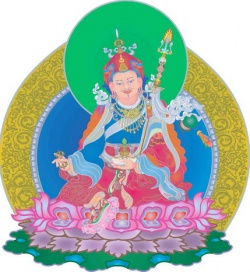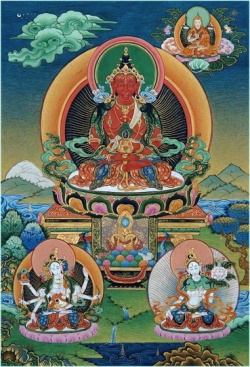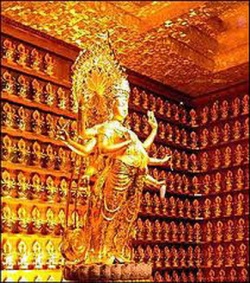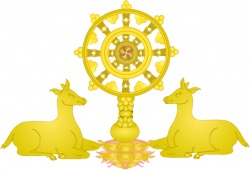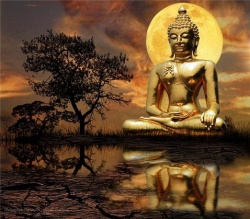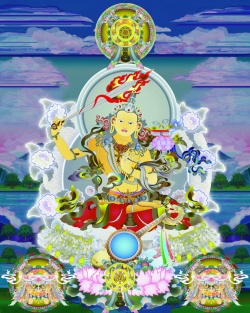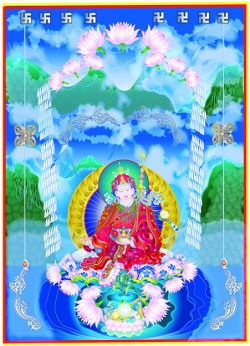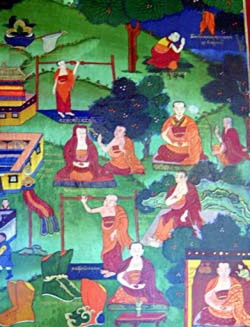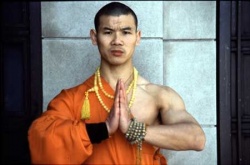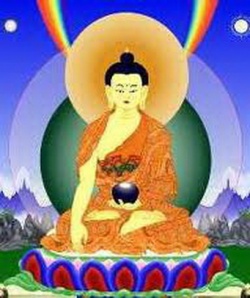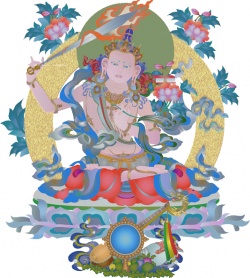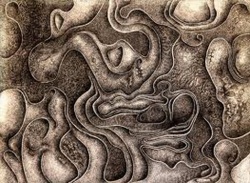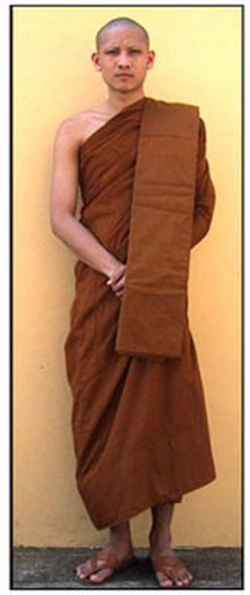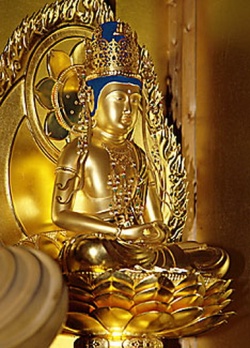The Abhidharma by Peter Della Santina, Ph.D.
The Abhidharma
Peter Della Santina, Ph.D.
* Note: This Section is an extract from the book "The Tree of Enlightenment: An Introduction to the Major Traditions of Buddhism", written by Dr. Peter Della Santina, 1987, and published on the Internet by the Chico Dharma Study Group, 26 Kirk Way, Chico, CA. 95928, U.S.A. -
E-mail: dsantina@ecst.csuchico.edu - Web site: http://www.ecst.csuchico.edu/~dsantina/
* About the Author: Peter Della Santina was born in the USA. He has spent many years studying and teaching in South and East Asia. He received his BA. in religion from Wesleyan University, Middletown, Connecticut, USA in 1972 and a MA in philosophy from the University of Delhi, India two years later. He did his Ph.D. in Buddhist Studies also from the University of Delhi, India in 1979.
He worked for three years for the Institute for Advanced Studies of world Religions, Fort Lee, New Jersey as a research scholar translating 8th century Buddhist philosophical texts from the Tibetan. He taught at several Universities and Buddhist centers in Europe and Asia including, the University of Pisa in Italy, the National University of Singapore and Tibet House in Delhi, India. He was the Coordinator of the Buddhist Studies project at the Curriculum Development Institute of Singapore, a department of the Ministry of Education from 1983 to 1985. More recently, he was a senior fellow at the Indian Institute of Advanced Study, Simla, India and taught Philosophy at the Fo Kuang Shan Academy of Chinese Buddhism , Kaoh-shiung, Taiwan. For twenty-five years Peter Della Santina has been a student of H.H. Sakya Trizin, leader of the Sakya Order of Tibetan Buddhism and of eminent abets of the Sakya Tradition.
He has practiced Buddhist meditation and has completed a number of retreats. He has published several books and articles in academic journals including Nagarjuna's Letter to King Gautamiputra, Delhi 1978 and 1982 and Madhyamaka Schools In India, Delhi 1986 and the Madhyamaka and Modern Western Philosophy, Philosophy East and West, Hawaii, 1986.
An Introduction to the Abhidharma
In this series, I will discuss the philosophical and psychological aspects of Buddhism presented in the seven books of the Abhidharma Pitaka of the Pali canon. I will not look in great detail at the lists of factors, or dharmas, found in many competent books on the Abhidharma. Instead, my objectives here are three: (1) to outline and describe the principal methods and characteristics of the Abhidharma, (2) to relate the Abhidharma to what we generally know about the teachings of the Buddha, and (3) to relate Abhidharma philosophy to our situation as lay Buddhists.
Throughout the history of Buddhism, the Abhidharma has been held in high esteem. In the books of the Pali canon, for example, the Abhidharma is spoken of in terms of praise and special regard. There the Abhidharma is the special domain of the elder monks; novices are even asked not to interrupt the Elders when they are engaged in a discussion of the Abhidharma. We also find the Abhidharma recommended only for those who sincerely strive to realize the goal of Buddhist practice, and that a knowledge of it is recommended for teachers of the Dharma.
This traditional regard for the Abhidharma is found not only in the Theravada tradition but in other major Buddhist traditions as well. For instance, Kumarajiva, the great Central Asian translator renowned for his translation of Madhyamaka works into Chinese, is said to have firmly believed that he must introduce the Abhidharma to the Chinese if he wished to teach them Buddhist philosophy. In the Tibetan tradition, also, the Abhidharma is an important part of monastic training.
Why is the Abhidharma held in such high esteem? The basic reason is that a knowledge of the Abhidharma, in the general sense of understanding the ultimate teaching, is absolutely necessary to achieve wisdom, which is in turn necessary to achieve freedom. No matter how long one meditates or how virtuous a life one leads, without insight into the real nature of things, one cannot achieve freedom.
A knowledge of the Abhidharma is necessary in order to apply the insight into impermanence, impersonality, and insubstantiality that we gain from a reading of the Sutra Pitaka to every experience of daily life. All of us may glimpse impermanence, impersonality, and insubstantiality through reading the Sutra Pitaka, but how often can we apply that momentary intellectual truth to our daily existence? The system in the Abhidharma teaching provides a mechanism for doing so. A study of the Abhidharma is therefore extremely useful for our practice.
Let us consider the origin and authenticity of the Abhidharma. The Theravada school holds that the Buddha is the source of the Abhidharma philosophy and was himself the first master of the Abhidharma because, on the night of his enlightenment, he penetrated the essence of the Abhidharma. According to a traditional account, the Buddha also spent the fourth week after his enlightenment in meditation on the Abhidharma. This is the week known as 'the House of Gems.' Later in his career, it is said that the Buddha visited the Heaven of the Thirty-Three, where his mother was, and taught the Abhidharma to her and the gods. It is said that when he returned to earth, he passed on the essentials of what he had taught to Sariputta--hardly a coincidence, since Sariputta was his foremost disciple, renowned for his wisdom.
Thus it is claimed in general that it is the Buddha to whom we owe the inspiration of the Abhidharma teaching. This inspiration was passed on to his disciples who were philosophically gifted, like Sariputta, and by the effort of these gifted disciples the general outline and contents of Abhidharma philosophy were established.
Let us go on to consider the meaning of the term abhidharma. If we look carefully at the Sutra Pitaka, we find this term occurring frequently, usually in the general sense of 'meditation about Dharma,' 'instruction about Dharma,' or 'discussion about Dharma.' In a more specific sense, abhidharma means 'special Dharma,' 'higher Dharma,' or 'further Dharma.' Here, of course, we are using Dharma in the sense of doctrine or teaching, not in the sense of phenomenon or factor of experience (in which case it would not be capitalized).
There is an even more technical sense in which the term abhidharma is used in the Sutra Pitaka, and in this context dharma no longer means doctrine in general but, rather, phenomenon. This technical use is associated with another function, that is to make distinctions. This most technical use of the term abhidharma has five aspects, or meanings: (a) to define dharmas; (b) to ascertain the relationship between dharmas; (c) to analyze dharmas; (d) to classify dharmas, and (e) to arrange dharmas in numerical order.
The Buddhist canon is divided into three collections (literally, 'baskets'): the Sutra Pitaka, the Vinaya Pitaka, and the Abhidharma Pitaka. The Sutra Pitaka is ordinarily termed the basket of the discourses, the Vinaya Pitaka contains the rules covering the monastic community, and the Abhidharma Pitaka is normally referred to as the books of Buddhist philosophy and psychology. Here I would like to look at the relationship between the Abhidharma Pitaka and the Sutra Pitaka. There is a great deal of Abhidharmic material in the Sutra Pitaka. Remember the technical definition of abhidharma that we considered a moment ago. Keeping that in mind, we find in the Sutra Pitaka a number of discourses that are Abhidharmic in character: the Anguttara Nikaya, which presents an exposition of teachings arranged in numerical order; the Sangiti Sutta and Dasuttara Sutta, in which Sariputta expounds on items of the teachings arranged in numerical order; and the Anupada Sutta, a discourse in which Sariputta analyzes his meditative experience in Abhidharmic terms.
How, then, can we arrive at a distinction between the Abhidharma and the sutras? To do this we need to look at the second meaning of the term abhidharma, namely, its use in the sense of 'higher doctrine.' In the sutras the Buddha speaks from two points of view. First he speaks of beings, objects, the qualities and possessions of beings, the world, and the like, and he is often found making statements such as 'I myself will go to Uruvela.' Second, the Buddha proclaims in no uncertain terms that there is no 'I' and that all things are devoid of personality, substance, and so forth.
Obviously, the two standpoints in operation here are the conventional (vohara) and the ultimate (paramattha). We have everyday language like 'you' and 'I,' and we also have technical philosophical language that does not assume personality, objects, and so forth. This is the difference between the Sutric contents and the Abhidharmic contents of the teachings of the Buddha. By and large, the sutras use the conventional standpoint while the Abhidharma uses the ultimate standpoint. Yet there are passages in the sutras that describe impermanence, impersonality or insubstantiality, elements, and aggregates, and hence reflect the ultimate standpoint. In this context there is also a division of texts into those whose meaning is explicit and direct, and those whose meaning is implicit and indirect.
Why did the Buddha resort to these two standpoints, the conventional and the ultimate? For the answer we need to look at his excellence as a teacher and skill in choosing methods of teaching. If the Buddha had spoken to all his audiences only in terms of impermanence, insubstantiality, elements, and aggregates, I do not think the Buddhist community would have grown as quickly as it did during the sixth century B.C.E. At the same time, the Buddha knew that the ultimate standpoint is indispensable for a profound understanding of the Dharma, so his teachings do contain specific language for expressing the ultimate standpoint.
Philosophy and Psychology in the Abhidharma
One of the functions of the Abhidharma is definition. Definition is important because, to successfully communicate about a rather technical subject, we must know precisely what our terms mean. Thus I would like to look at a number of terms used frequently and popularly in speaking about Buddhist thought. I would like to arrive at an understanding of the definitions of these terms and then relate them to the nature of the teachings of the Buddha.
Buddhism has often been called a religion, a philosophy, and, in recent years, a psychology. 'Religion' refers to belief in, or recognition of, a higher, unseen power that controls the course of the universe. Moreover, religion has an emotional and moral component and has to do with rituals and worship. Because Buddhism does not recognize the existence of such a power and does not universally emphasize rituals and worship, it is difficult to categorize Buddhism in general -- and particularly the Abhidharma -- as a religion.
In its original sense, 'philosophy' means the 'love of wisdom and knowledge.' More generally, it means investigation of the nature of the laws or causes of all being. This definition might apply to Buddhism except that it remains somewhat vague, due to the various meanings of the words 'nature' and 'being.' This has led to two approaches in philosophical thinking, called metaphysics and phenomenology. Metaphysics is the study of absolute or first principles. It is also sometimes called the science of ontology, which means the study of essences or, in simple terms, the study of things in themselves. Phenomenology, in contrast, is the description of things as they are experienced by the individual; it is the science of epistemology, the study of things as they are known, as they appear to us. Insofar as Buddhism is philosophical, it is concerned primarily with phenomenology.
'Psychology' is the study of the mind and mental states. Like philosophy, it has two aspects--pure psychology, which is the general study of mental phenomena, and psychotherapy, or applied psychology, which is the application of the study of mental phenomena to the problem of disease and cure, disturbance and adjustment. We might explain the difference between pure and applied psychology by means of an analogy. Imagine that a man climbs to the top of a hill and surveys the countryside without any particular purpose in mind. His survey will take in every detail--the hills, the woods, the rivers and streams -- without discrimination. But if he has a purpose in mind--for instance, if he intends to reach another hilltop in the distance -- then his survey will focus on the particular features that will help or hinder him in his progress toward that goal. When we speak of applied psychology or psychotherapy, we mean a study of the mind and mental states that focuses on those phenomena that will help or hinder one's progress toward mental well-being.
Having looked briefly at the definitions of religion, philosophy, and psychology, we can begin to see that the phenomenological aspect of philosophy and the therapeutic aspect of psychology relate best to an understanding of the Buddha's teaching.
The Abhidharma, like Buddhist thought in general, is highly rational and logical. If we look closely at the methods of exposition and argument in the Abhidharma, we find the beginning of dialectics, which is the science of debate, and also the beginning of logical argument and analysis. This is particularly evident in the fourfold classification of the nature of questions. It is said that familiarity with and ability to use this classification is indispensable for anyone who wants to engage fruitfully in discussion and debate about the Dharma, because to answer a question correctly, one has to understand the nature of the question.
The first class of questions is the most direct and refers to those that can be answered directly and categorically, such as 'Do all living beings die?' To this the answer is 'Yes, all living beings die.'
The second class can only be answered with qualifications, for instance, 'Will all living beings be reborn?' This kind of question cannot be answered directly and categorically because it has two possible interpretations. Thus it must be analyzed and answered individually, taking into account each of the possible meanings: 'Living beings who are not free from the afflictions will be reborn, but those who are free from the afflictions, like the Arhats, will not be reborn.'
The third class of questions must be answered with counter-questions, as, for instance, 'Is man powerful?' Here the reference point of the question must be determined before the question can be answered: in other words, is man powerful with reference to the gods or to animals? If the former, then man is not powerful; if the latter, then man is powerful. The aim of the counter-question is to determine the reference point that the questioner has in mind.
The fourth class of questions are those in which we are particularly interested here. These are questions that do not deserve an answer; the famous inexpressible propositions to which the Buddha remained silent fall into this category. Traditionally, there are fourteen unanswerable questions. We find them, for instance, in the Chulamalunkya Sutta. These fourteen questions are grouped into three categories:
The first category contains eight questions that concern the absolute or final nature of the world: Is the world eternal or not eternal, or both or neither; finite or not finite, or both or neither? You can see that this category includes two sets of questions, and that both sets refer to the world. The first set refers to the existence of the world in time, and the second to the existence of the world in space.
The second category contains four questions: Does the Tathagata exist after death or not, or both or neither? These questions refer to the nature of nirvana, or ultimate reality.
The third category contains two questions: Is the self identical with or different from the body? While the first category of questions refers to the world and the second to what is beyond the world, this last refers to personal experience. Do we die with our bodies, or are our personalities altogether different from and independent of our bodies?
The Buddha remained silent when asked these fourteen questions. He described them as a net and refused to be drawn into such a net of theories, speculations, and dogmas. He said that it was because he was free of the bondage of all theories and dogmas that he had attained liberation. Such speculations, he said, are attended by fever, unease, bewilderment, and suffering, and it is by freeing oneself of them that one achieves liberation.
Let us look at the fourteen questions in general to see whether we can understand why the Buddha took this stand. Generally, the fourteen questions imply two basic attitudes toward the world. The Buddha spoke of these two attitudes in his dialogue with Maha Kachchayana, when he said that there are two basic views, the view of existence and the view of nonexistence. He said that people are accustomed to think in these terms, and that as long as they remain entangled in these two views they will not attain liberation. The propositions that the world is eternal, that the world is infinite, that the Tathagatha exists after death, and that the self is independent of the body reflect the view of existence. The propositions that the world is not eternal, that the world is finite, that the Tathagata does not exist after death, and that the self is identical with the body reflect the view of nonexistence.
These two views were professed by teachers of other schools during the time of the Buddha. The view of existence is generally the view of the Brahmins; that of nonexistence is generally the view of the materialists and hedonists. When the Buddha refused to be drawn into the net of these dogmatic views of existence and nonexistence, I think he had two things in mind: (1) the ethical consequences of these two views, and, more importantly, (2) the fact that the views of absolute existence and nonexistence do not correspond to the way things really are.
For example, the eternalists view this self as permanent and unchanging. When the body dies, this self will not die because the self is by nature unchanging. If that is the case, it does not matter what this body does: actions of the body will not affect the destiny of the self. This view is incompatible with moral responsibility because if the self is eternal and unchanging, it will not be affected by wholesome and unwholesome actions. Similarly, if the self were identical with the body and the self dies along with the body, then it does not matter what the body does. If you believe that existence ends at death, there will be no constraint upon action. But in a situation where things exist through interdependent origination, absolute existence and nonexistence are impossible.
Another example drawn from the fourteen unanswerable questions also shows that the propositions do not correspond to the way things really are. Take the example of the world. The world does not exist absolutely or not exist absolutely in time. The world exists dependent on causes and conditions--ignorance, craving, and clinging. When ignorance, craving, and clinging are present, the world exists; when they are not present, the world ceases to exist. Hence the question of the absolute existence or nonexistence of the world is unanswerable.
The same may be said of the other categories of questions that make up the fourteen unanswerables. Existence and nonexistence, taken as absolute ideas, do not apply to things as they really are. This is why the Buddha refused to agree to absolute statements about the nature of things. He saw that the absolute categories of metaphysics do not apply to things as they really are.
As for the Buddha's attitude toward psychology, there is no doubt that he placed a great deal of emphasis on the role of the mind. We are familiar with the famous verses in the Dhammapada where the Buddha speaks of the mind as the forerunner of all mental states. The text says that happiness and suffering result from acting with a pure mind and an impure mind, respectively. We need only look at the canonical texts to recognize the importance of mind in Buddhist teachings. There we find the five aggregates, four out of five of which are mental, and the thirty-seven factors of enlightenment, the majority of which are mental. No matter where we look, we will be struck by the importance of mind in the teachings of the Buddha.
Various religions and philosophies have their particular starting points. The theistic religions begin with God. Ethical teachings like Confucianism begin with man as a social entity. Buddhism begins with the mind. It is therefore not surprising that we often choose to describe the Buddha's teaching as a psychological one, and that we also describe it as psychotherapy, since the symbolism of disease and cure is prominent in the teaching of the Buddha. The Four Noble Truths are a reflection of the ancient scheme of disease, diagnosis, cure, and treatment used in early medical science, and we might also recall that the Buddha was called the king of physicians.
The Buddha was interested in cure, not in metaphysical categories. We find his use of various techniques of cure throughout the discourses in the Sutra Pitaka. For instance, take the Buddha's teaching about the self. In the Dhammapada the Buddha taught that the wise man can attain happiness by disciplining himself, and yet in other places in the discourses, we find the Buddha expounding the doctrine of not-self, the idea that nowhere in the psycho-physical components of experience is the permanent self to be found.
For the explanation of this apparent contradiction, we need to look at the Buddha's dialogue with Vachchhagotta, who asked the Buddha whether or not the self existed. The Buddha remained silent, and after a time Vachchhagotta left. Ananda, who happened to be nearby, asked the Buddha why he had not replied. The Buddha explained that if he had said that the self existed, he would have been siding with those Brahmins who believed in the absolute existence of the self, but if he had told Vachchhagotta that the self did not exist, it would have been confusing for Vachchhagotta, who would have thought, 'Previously I had a self, but now I no longer have one.' The Buddha chose to remain silent because he knew Vachchhagotta's predicament. Similarly, when confronted by those who did not believe in rebirth, he taught the existence of the self, whereas to those who believed in the reality of karma, in the fruit of good and bad actions, he taught the doctrine of not-self. This is the Buddha's skill in the means of instruction.
We can see how this ties in with the Buddha's rejection of absolute categories when we look at his use of the symbol of the water-snake. Here we find the Buddha saying that the factors of experience are similar to a water-snake. When a person capable of handling a water-snake and knowledgeable in the method of capturing one attempts to catch one, he will do so successfully. But when a person unaccustomed to handling a water-snake and ignorant of how to capture one attempts it, his attempt will end in lamentation and pain. Similarly, phenomena--the factors of experience--are nothing in themselves. They are not absolutely existent or absolutely nonexistent, neither absolutely good nor absolutely bad; rather, they are relative. Whether they result in happiness or pain, in progress along the path or in retrogression, depends not on the phenomena themselves but on how we handle them.
If things are handled in the right way, through a conscious and deliberate adjustment of the mind, phenomena can be used for one's progress along the path. A knife, for instance, is neither true nor false, yet someone who grasps it by the blade is surely in error. When we relate to phenomena in terms of craving, ill-will, and ignorance, this results in suffering. When we take them otherwise, this results in happiness.
To summarize, we can use terms like 'philosophy' and 'psychology' in relation to the Buddhist tradition as long as we remember that we are interested in philosophy not as it concerns essences and absolute categories but as a description of phenomena, and that we are interested in psychology insofar as it concerns psychotherapy. These qualities of the philosophy and psychology of the Abhidharma are unique in the history of human thought. Nowhere else, in the ancient or modern world, in Asia or the West, has such a phenomenology and psychotherapy evolved.
What is unique about Buddhist phenomenology and psychotherapy is its rejection of the idea of a permanent self and its affirmation of the possibility of liberation. In all other systems, even those of western philosophical phenomenology and psychotherapy, we find an inability to reject the idea of a permanent self--the very rejection so characteristic of the teaching of the Buddha and of the Abhidharma. And nowhere within modern psychology do we find that possibility of ultimate and absolute freedom so central to the teachings of Buddhism.
Methodology
In this chapter, I will discuss the methods through which the Abhidharma investigates our personalities and our relations to the world around us.
There are two ways to depict a given person and his relation to the world around him: deductively and inductively. The rational or deductive method begins with an abstract idea and applies that idea to one's experience. The empirical or inductive method begins with the facts we encounter in experience; through observing and analyzing, interpreting and understanding these facts, we build up a picture of ourselves and the world around us. In short, the rational method begins with the abstract and tries to apply it to the concrete, whereas the inductive method begins with the concrete and builds up a picture of reality gradually and progressively.
The inductive method, which is the one used in the Abhidharmic system, is quite close to the method of science, except that in science the focus of the inductive process is outward and in the Abhidharmic system the focus is inward, on the mind. This is why the Abhidharmic method is sometimes called introspection or, to use a traditional term, meditation.
When we say that the Abhidharmic method is empirical and inductive, we mean that it has to do primarily with mental experience. Sometimes we say that meditation is like internal or mental microscopy: it is a way of investigating very closely the facts of experience. The Abhidharmic method of introspection yields results because it manages, through meditation, to slow down mental processes to a point where we can see and understand them. In this respect there is a remarkable parallel between the Abhidharmic method and the scientific method. In science, when we want to find out how a certain transformation actually takes place, we slow down the process or speed it up. In Abhidharmic meditation, too, we can slow down mental processes so that we can see what is actually happening, or we can speed things up. If we could see our human life, from birth to death, within the space of five minutes, it would give us great insight into the nature of life. However, because this is usually not possible, we slow things down. This is the basis of Abhidharmic meditation.
The lists of mental factors and the like in the books of the Abhidharma may appear tedious and speculative at first glance, but in fact they are just the written form of the data we find in this very careful investigation of experience. Far from being speculative, the Abhidharma is the result of careful and close introspective analysis of experience. That said, you may question the use of studying the Abhidharma at all, thinking that it is surely more useful to sit in meditation and reproduce the Abhidharmic experience of reality in one's own meditation. This is true to the extent that, as in all aspects of Buddhist teaching, direct as well as indirect acquaintance is required.
With the Abhidharmic view of the elements, the picture we get when we analyze experience is certainly much more effective if it is a direct picture achieved through our own meditation. But even if it is an indirect picture gained through study, it is still of use to us, because when we sit down to meditate we will already have some intellectual acquaintance with the general outline of the picture we are trying to bring into focus. In this sense studying the Abhidharma can be useful in bringing about an indirect understanding of ourselves and the world around us in Abhidharmic terms.
There are two ways Abhidharmic investigation works: (1) through analysis, and (2) through synthesis, or relation. The basic structure of these two methods is given in the first and last books of the Abhidharma Pitaka, the Dhammasangani (Classification of Factors) and the Patthana (Book of Causal Relations), respectively. These are the two most important books of the Abhidharma. It is through the analytical method and the synthetic or relational method that the Abhidharma arrives at a basic understanding of not-self and emptiness.
Let us look first at the analytical method and then at the relational method; finally, we will combine the two, as, indeed, we must to reap the full benefit of the Abhidharmic method of investigation. In The Questions of King Milinda (Milinda Panha), it is said that the Buddha has accomplished a very difficult task: 'If a man,' Nagasena says in reply to King Milinda, 'were to take a boat out to the sea, and if he were to take a handful of sea water and were then able to tell you that in it this much water is from the Ganges, this much from the Yamuna, and this much from the other great rivers of India, this would certainly be a very difficult thing to accomplish. In the same way, the Buddha has analyzed a single conscious moment of experience -- for instance, the experience of seeing a form--into its various component parts: matter, feeling, perception, volition, and consciousness.'
Analysis is the dissection of an apparently unitary, homogeneous whole into its component parts. This analysis can be applied not only to the self, as we find in the analysis of personal experience, but also to external objects: just as we can break down the personality into the five aggregates, so we can break down external phenomena into their component parts. For example, we can break down a table into its legs, its top, and so forth, and, even further, into the molecules and atoms of various elements that compose the table.
The purpose of dissecting an apparent whole is to uproot attachment to internal and external phenomena. Once we recognize that this apparently homogeneous self is really just a collection of components, our attachment to the notion of the self is weakened; similarly, once we realize that external phenomena are just collections of individual smaller components, our attachment to external objects is weakened. What do we have as a result of our analytical process? Internally, we are left with moments of consciousness; externally, we are left with atoms. If we consider the two together, we are left with elements, or factors of experience.
The mental and material elements of experience do not in themselves bring us to the ultimate understanding of reality because we are left with moments of consciousness and atoms of matter--elements of experience. These elements remain irreducible no matter how long and how far we go in our process of dissection. Although we come up with smaller and smaller parts, we are left with a picture of reality that is broken up into little bits and pieces as a result of dissection. This in itself is not an accurate and complete picture of reality.
To arrive at the ultimate picture of reality, we need to couple the analytical approach with the synthetic or relational approach. That is why a great Buddhist scholar and saint, Nagarjuna, once expressed his reverence for the Buddha as 'the teacher of interdependent origination.' The truth of interdependent origination pacifies and calms the agitation of thought-construction. This is an indication of the importance of relation, interdependence, or conditionality in understanding the real nature of things. It is also why scholars have focused on the Book of Causal Relations, which supplies the other half of the Abhidharmic method of investigation.
Just as, through analysis, we arrive at the insubstantiality of personality and phenomena (because we see that they are made up of component parts), so, through the process of relational investigation, we arrive at the emptiness of personality and phenomena (because we see that the component parts which constitute them are all conditioned by and relative to each other). We arrive at this insubstantiality and emptiness by focusing on the teaching of interdependent origination.
We can see how, within a given thing--be it the personality or an external object--the component parts depend on one another for their existence. For instance, within a single phenomenon, such as an apparently unitary table, there are several component parts (the legs, the top, and so forth) that depend on each other for their existence as part of a table. Similarly, the table depends on its antecedent causes (the wood, the iron, and action of the craftsman who put it together) and also on proximate conditions (like the floor on which it stands).
We can also explore the idea of interdependence in relation to three dimensions: time, space, and karma. For instance, the table is dependent in terms of time in the sense that, prior to the table existing, a series of events occurred--the cutting of lumber, the construction of the table, and so forth. This sequence of events led to the arising of the table. Similarly, the table is dependent in terms of space in the sense that it stands on the floor, and so forth. The third dimension of conditionality operates beyond time and space. This dimension is explained by karma, because karma has its effects depending on time and space, yet it is not directly apparent in time and space. Because of karma, an action done at a very distant point in time and space can have its effects here and now. Conditionality is therefore not only temporal and spatial, but also has a karmic dimension.
Let us take two examples to establish more firmly what we mean by the analytical approach and the relational approach. Take a chariot, which is a phenomenon, an identifiable entity. We apply the analytical approach to the chariot by breaking it down into its component parts: the wheels, axle, body, shaft, and so forth. Application of the synthetic method looks at the same chariot in terms of the lumber that goes to it, the action of the builders who put it together, and so forth. Alternatively, we can take the classical examples of the flame in an oil lamp, which exists dependent on the oil and the wick, and the sprout, which depends on a seed, soil, sunlight, and so forth.
The analytical and the relational methods together yield the ultimate picture of things as they really are. They yield this ultimate picture through careful investigation. We use the analytical method to break things up into the component parts of an apparent whole; then we use the relational method to show that these component parts do not exist independently and separately but depend on other factors for their existence.
There are many places in the Buddha's teaching where methods of investigation are used singly and then in combination. For example, we apply mindfulness first to internal phenomena, then to external phenomena, and finally both to internal and external phenomena. By using analysis and relation together, we overcome many problems. Not only do we overcome the idea of self, substance, and personality, we also overcome the problems that result if we believe in the independent existence of separate factors and ideas like existence and nonexistence, identity and difference.
The analytical and the synthetic approaches are actually reflected in the chemistry of the brain. Neurologists have discovered that the brain is divided into two hemispheres, one whose function is analytical and one whose function is synthetic. If these two functions are not in harmony, not in balance, personality disturbances result. Someone who is too analytical tends to overlook the more intuitive, dynamic, fluid aspects of life, while someone who is too relational tends to lack precision, clarity, and focus. Thus even in our personal lives we need to combine analytical and relational thinking.
The psychological and neurological dimensions of these two approaches are also clear in the development of western philosophy and science. Philosophies in which the analytical approach is predominant have left us with realistic, pluralistic, and atomistic systems like the philosophy of Bertrand Russell. By the same token, in the latest developments of science, such as quantum theory, we find a more relational view of reality gaining ground. When we look at the history of philosophy and science in the West, we can see that each of these two approaches to investigation has been dominant at one time or another.
Perhaps we are reaching a point where we can combine the two even in western science and philosophy. Perhaps we can arrive at a view of reality not too different from the one that the Abhidharma arrives at through the experience of introspective meditation -- a view of reality that is both analytical (in that it rejects the idea of a homogeneous whole) and relational (in that it rejects the idea of independent, separately existing bits and pieces of reality). We would then have a very fluid and open view of reality in which experience saturated by suffering could be dynamically transformed into experience free from all suffering.
Analysis of Consciousness
Because of its importance and scope, I will dedicate three chapters to the analysis of consciousness within Abhidharma philosophy. In this chapter I look at some of the systems for classifying consciousness and also at the sense-sphere consciousness in particular.
To understand why we begin our Abhidharmic analysis of experience with consciousness, it is important to remember the therapeutic concern of Buddhist philosophy in general and the Abhidharma in particular. The starting point of Buddhist thought is the truth of suffering. Suffering is a problem of consciousness; only that which is conscious can suffer. Consciousness is subject to suffering because of ignorance, or fundamental not-knowing, which divides consciousness into subject and object, into a self and an other-than-self (i.e., the objects and people around the self).
In Buddhism, ignorance is defined as the notion of a permanent, independent self and its object. Once we have this division of consciousness into a self and an other-than-self, we have suffering, because tension is created between the two. We also have craving and aversion, because we want those things that support the self and are averse to those things that are not conducive to the self.
This division or discrimination between the self (or subject) and the other-than-the-self (or object) is the fundamental cause of suffering. Such a division is possible because of ignorance -- the belief in a real self existing independently and in opposition to the other-than-self. Thus it is not surprising that the Abhidharma should turn first to an analysis of subjectivity and objectivity. Indeed, when we examine the teaching of the five aggregates, we see that form (rupa) is the objective component, while name (nama), consciousness, and the mental aggregates of volition, perception, and feeling are the subjective component. Before looking at how this division affects the Abhidharmic analysis of consciousness, we must be clear about what it means. In Buddhism, this division does not mean that we have an essential, irreducible duality of mind and matter. Buddhism is not concerned with mind and matter as ultimate metaphysical facts but with mind and matter as they are experienced. Mind and matter are forms of experience, not essences. This is why Buddhism is a phenomenological, not an ontological, philosophy, and why the division of mind and matter in Buddhism is a phenomenological division.
There are two systems for classifying consciousness in the Abhidharma: objective and subjective. Objective classification refers to the objects of consciousness, while subjective classification refers to the nature of consciousness.
Objective classification primarily takes into account the direction in which consciousness is oriented. Within this objective scheme, there is a division into four classes of consciousness: (1) the sense-sphere consciousness, or consciousness directed toward the world of sense desire (kamavachara); (2) the consciousness directed toward the sphere of form (rupavachara); (3) the consciousness directed toward the formless sphere (arupavachara); and (4) the consciousness directed toward nirvana (lokuttara). The first three classes of consciousness are worldly (lokiya) and are concerned with the world of conditioned things. The fourth class, also known as supramundane consciousness (alokiya chitta), refers to the transcendental direction of consciousness (lokuttara) and is the consciousness of the four types of noble ones--the stream-winner, once-returner, non-returner, and liberated one (see Chapter 5).
The object of the kamavachara is material and limited; the object of the rupavachara is not material but is still limited; and the object of the arupavachara is not material and is unlimited. If we look at these three in order, we find (a) a material and limited object, (b) an immaterial but still limited object, and (c) an immaterial and unlimited object of consciousness. All three types of consciousness are directed toward mundane objects. There is a progressive unification and homogenization in the object of each consciousness. The object of the consciousness of the sphere of sense desire is the most proliferated and differentiated, those of the form and formless types of consciousness are increasingly less proliferated. The fourth type of consciousness is directed toward a transcendental type of object.
Let us now look at the subjective classification of consciousness. This consciousness has to do with the nature of the subjective consciousness itself and is also divided into four classes: the wholesome consciousness (kusala), the unwholesome consciousness (akusala), the resultant consciousness (vipaka), and the ineffective or functional consciousness (kiriya).
The wholesome and unwholesome classes are karmically active classes of consciousness; in other words, they have karmic potential. The resultant and functional types of consciousness are not karmically active and do not have karmic potential. The resultant class cannot bring about results because it is itself the result, while the functional class cannot do so because its potentiality is exhausted in the action itself.
We can thus place the wholesome and unwholesome categories in the more general category of karmically active consciousnesses, and the resultant and functional types into the category of passive consciousnesses that do not have karmic potential.
It might be useful to look for a moment at the meaning of the terms 'wholesome' (kusala) and 'unwholesome' (akusala), and then at the definition of the wholesome and unwholesome categories of subjective consciousness. Wholesome means 'what tends toward cure' or 'what tends toward desirable results.' Here we are again reminded of the therapeutic concern of Buddhist philosophy. Unwholesome means 'what tends toward undesirable results' or 'what tends toward perpetuation of suffering.' The terms 'wholesome' and 'unwholesome' are also related to skillful and unskillful, or intelligent and unintelligent, moments of consciousness. However, for convenience, people still sometimes refer to wholesome and unwholesome consciousness as good and bad, moral and immoral. 'Wholesome' and 'unwholesome' can also be defined with reference to the three wholesome and unwholesome root causes (non-greed, non ill-will, and non-delusion, and greed, ill-will, and delusion, respectively). Greed, ill-will, and delusion are the derivative forms of fundamental ignorance, which is the mistaken notion of a self as opposed to what is other-than-self. Ignorance in its fundamental sense might be likened to the root of a tree, and greed, ill-will, and delusion to its branches.
The karmic potential of a moment of consciousness conditioned by any of the three unwholesome causes is unwholesome, while the potential of a moment conditioned by any of the three wholesome causes is wholesome. These wholesome and unwholesome classes of consciousness are karmically active, and they are followed by a resultant class--in other words, by the ripened results of those wholesome and unwholesome actions. The inactive or functional class refers to actions that are not productive of further karma, and that also do not result from wholesome and unwholesome karma, such as the actions of enlightened ones--the Buddhas and Arhats--and deeds of indifferent or neutral karmic content.
In addition to these two general systems for classifying consciousness -- the objective, which classifies consciousness according to its object and direction, and the subjective, which classifies consciousness according to its nature -- we have a third system in which consciousness is distinguished according to feeling, knowledge, and volition.
In the classification according to feeling, every conscious factor partakes of an emotional quality: agreeable, disagreeable, or indifferent. These three can be expanded into five by dividing the agreeable category into mentally agreeable and physically agreeable, and the disagreeable category into mentally disagreeable and physically disagreeable. There is no category of physically indifferent consciousness because indifference is primarily a mental quality.
In the classification in terms of knowledge, again we have a threefold division: conscious factors accompanied by knowledge of the nature of the object, conscious factors unaccompanied by knowledge of the nature of the object, and conscious factors accompanied by definite wrong views about the nature of the object. These can also be called the presence of correct knowledge, the absence of correct knowledge, and the presence of erroneous knowledge.
Finally, in the classification according to volition, there is a twofold division into automatic and volitional consciousness--in other words, moments of consciousness that are automatic in nature, and moments that have an intentional element.
Let us now look at the sense-sphere consciousness (kamavachara). There are fifty-four types of consciousness in this category, which divide into three groups:
The first group consists of twelve factors that are karmically active and that have unwholesome karmic potential. The twelve can be subdivided into factors conditioned by one of the three unwholesome conditions of greed, ill-will, and delusion.
The second group consists of eighteen reactive or passive factors of consciousness, which can be further broken down into those that are resultant and those that are functional. Fifteen of the eighteen are resultant, and refer in general terms to experiences that are agreeable or disagreeable, the result of wholesome or unwholesome factors experienced through the five physical senses and the sixth mental sense. The remaining three are functional, having no karmic potential and not being the consequence of karmically active wholesome or unwholesome factors.
The third category consists of twenty-four wholesome factors of consciousness that are karmically active and thus have karmic potential conditioned by non-greed, non-ill-will, and non-delusion.
Within the class of sense-sphere consciousness, therefore, we have fifty-four types of consciousness that can be analyzed in terms of active and passive, wholesome and unwholesome, resultant and functional, and even in terms of feeling, knowledge, and volition.
I want to conclude by spending a few moments on the multivalent nature of terms in the Abhidharma in particular and in Buddhism in general. The factors of consciousness listed in the Abhidharma, and the terms used to describe them, have different values and meanings according to the functions they perform. Failure to understand this leads to confusion about Abhidharmic classifications.
Even in the early years of the Abhidharma, there were critics who failed to understand that the factors in it are classified functionally, not ontologically. What this means is that if you survey the factors of consciousness listed in the Abhidharma literature, you find the same factor occurring in different categories. Your initial conclusion may be that there is a great deal of repetition in Abhidharmic material, but this is not the point. The presence of the same factor in different categories is due to its functioning differently in each one.
The commentary to the Dhammasangani (Classification of Factors) records the objection of repetition raised by an opponent. It replies with the analogy that when a king collects taxes from people, he does so not on the basis of their existence as identifiable individuals, but of their functions as earning entities. (This is also the case today, when one pays taxes on the basis of being a property owner, a salaried worker, on the earnings of one's stocks and bonds, and so forth.) In the same way, the factors enumerated in the Abhidharma occur in different categories because in each case it is the factor's function that counts, not its essence.
This is also the case with terms. We need to understand terms in context--by the way they are used--rather than imposing rigid, essentialistic, and naturalistic definitions. Take, for instance, 'suffering' (dukkha) and 'happiness' (sukha). In the analysis of the factors of consciousness, these terms mean physical suffering and physical happiness. Yet when we talk about dukkha in the context of the first noble truth, it includes not only four physical sufferings but also four mental sufferings. Similarly, sankhara means simply 'volition' in one context but 'all compounded things' in another.
Thus when we study the Abhidharma, we need to understand the words in context. If we keep this in mind, we will be adopting the phenomenological spirit of Buddhist philosophy and will find it easier to approach the significance of what is being said. Otherwise, we will find ourselves trapped into rigid, unworkable definitions of terms and rigid, unhelpful ideas about factors of experience.
The Form and Formless Spheres
In Chapter 3, I introduced several schemes for classifying consciousness that may be difficult to grasp, particularly for newcomers to Abhidharmic studies. Hence there are two additional points I would like to make as we proceed with our discussion.
First, to acquire understanding, one needs to cultivate (1) study, (2) consideration, and (3) meditation. It is not enough just to hear or read about the classifications of consciousness: one needs to consider exactly how they function, exactly what their meaning is. From my own experience, these schemes of classification will not begin to make sense until one spends some time running them back and forth in one's mind. Finally, after study and consideration, one can use them in one's meditation.
Second, to understand these classifications, it helps to consider a more concrete and accessible model. Suppose you want to know how many people are likely to watch daytime television in Singapore. You might classify the population into employed and unemployed; again, you might divide the unemployed group into English-speaking and Chinese-speaking, so you know how many are likely to watch English programs compared to Chinese ones. You might divide the population into male and female, or into school-going and non-school-going, and the school-going group into those who attend English schools and those who attend Chinese schools. Given a certain group of factors -- in this case, the individual people who make up a population -- there are many ways to classify them depending on what you want to find out.
It is the same way with the Abhidharmic classification of consciousness: we have a set of types of consciousness, and we classify them in different ways according to what we want to find out. If we remember this general rule about why and how we classify factors of consciousness, and then run the schemes back and forth in our minds, they will begin to make more sense.
In this chapter we will look at the form-sphere consciousness (rupavachara) and the formless-sphere consciousness (arupavachara; see Chapter 3). Here we are primarily concerned with the analysis of types of consciousness that arise from meditation, concentration, or absorption (jhana). As in the genesis of the Abhidharma itself, Sariputta played a vital role in the beginnings of Abhidharmic analysis of consciousness. In the Anupada Sutta it is mentioned that, after achieving the various states of meditation, Sariputta applied an Abhidharmic type of analysis by enumerating, classifying, and identifying the types of consciousness he had experienced.
Much emphasis was placed on analysis even in the early period of Buddhist history, because the experience of extraordinary states of meditation can be easily misinterpreted. In non-Buddhist traditions, such states are consistently misinterpreted as evidence of a transcendental, supranatural being or of an eternal soul.
By pointing out that states of meditation, like experience in general, are characterized by impermanence, transience, and insubstantiality, analysis wards off the three defilements of: (a) craving or attachment to the supernatural and extraordinary states of consciousness achieved through meditation; (b) false views, that is, the misinterpretation of these states of meditation as evidence of the existence of a transcendental being or eternal soul; and (c) conceit, which arises from the notion that one has achieved extraordinary states of meditation.
The cultivation of states of meditation and the attainment of the absorptions is a very important part of Buddhist practice because it is the aim of mental development, which is one of the three major divisions of the Buddhist path (i.e., morality, mental development, and wisdom). To achieve these states of meditation, one needs to create the foundation of morality and withdraw to some extent from involvement in worldly activities. Having achieved these preliminary conditions, one then proceeds to cultivate the states of meditation through various methods.
Briefly, one proceeds by means of some forty traditional objects of meditation, which include ten supports (kasina). These objects are coordinated to the temperament of the meditator. In other words, particular objects of meditation are prescribed for certain kinds of temperament. In general, one begins with an external support, gradually that external support is internalized and conceptualized, and finally that support is discarded and one enters the state of meditation proper.
Five factors of absorption (jhananga) are crucial to developing the states of meditation that result in the type of consciousness belonging to the form and formless spheres: (i) initial application (vitakka), (ii) sustained application (vichara), (iii) interest, enthusiasm, or rapture (piti), (iv) happiness or bliss (sukha), and (v) one-pointedness (ekaggata). These five factors are also evident in most types of consciousness, including the sense-sphere consciousness and even the consciousness of some of the more developed animals.
Take, for instance, one-pointedness. Every conscious moment participates in one-pointedness to some degree. This one-pointedness enables us to focus on a particular object in our conscious experience. If it were not for one-pointedness, we would not be able to pick out an object of consciousness from the stream of objects of consciousness. The five factors of absorption play a particular role in the development of meditative consciousness in that they raise our consciousness from the sense sphere to the form sphere, and thence to the formless sphere, through intensification. Intensification implies the enhancement and development of the power of particular functions of consciousness. Intensification of the first two factors, initial application and sustained application, leads to the development of the intellect, which can then serve to develop insight. Similarly, intensification of the fifth factor, one-pointedness, leads to the development of fully concentrated or absorbed consciousness. Intensification of all five factors leads progressively to the attainment of supernormal powers.
The five factors also help elevate one's consciousness from the sense sphere to the form and formless spheres by removing the five hindrances (nivarana): initial application corrects sloth and torpor; sustained application corrects doubt; enthusiasm corrects ill-will; happiness corrects restlessness and worry; and one-pointedness corrects sensual desire.
Let us look more closely at the five factors of absorption to see how they produce concentrated consciousness. To do this, we need to look in greater detail at their meaning. In the context of developing meditative consciousness, initial application (vitakka) is better termed 'applied thought,' since it means 'hitting upon,' 'striking,' or 'mounting.' Vitakka mounts the mind, placing it on the object of meditation; vichara (sustained application) then keeps the mind firmly on that object, maintaining the placement of the mind. The third factor of absorption--enthusiasm, interest, or rapture (piti)--motivates one to pursue the activity of meditation diligently.
It may be helpful to contrast interest (piti) and happiness (sukha) to understand the relationship between the two. Interest and happiness belong to two different classes of experience: interest to the volitional class (sankhara), and happiness to the feeling class (vedana). On the one hand, interest is active anticipation and enthusiasm; on the other hand, happiness is a feeling of contentment or bliss. The commentaries have given the following example to illustrate the relation between the terms. Suppose a man in a desert is told that there is a pond of fresh water at the edge of a village nearby. Upon hearing the news, he experiences a keen sense of interest (piti) and is motivated and encouraged by the information. But when he actually reaches the pond and quenches his thirst, he experiences happiness (sukha). Thus it is interest or enthusiasm that encourages us to proceed toward concentrated consciousness, whereas happiness or bliss is the actual experience of mental happiness that results from concentrated consciousness.
One-pointedness (ekaggata) is collection, non-distraction of the mind, focusing the mind without wavering on the object of meditation. It is like the flame of a lamp which remains steadfast in a room free of drafts.
When all five factors of absorption are present, we have the first form-sphere consciousness, or absorption. As factors of absorption are eliminated one by one, we progress step by step to the fifth form-sphere consciousness. In other words, when we eliminate initial application, we have the second form-sphere absorption; when sustained application is removed, we have the third form-sphere absorption; when interest is removed, we have the fourth form-sphere absorption; and when happiness is removed, we have the fifth form-sphere absorption.
These five types of consciousness are karmically active, wholesome types of consciousness. In addition, there are five reactive, resultant and five inactive or functional types of consciousness. The first five are karmically active and are present in this life. The second five are the result of the first five; in other words, cultivation of form-sphere absorption results in rebirth in the form sphere. The third five are the five form-sphere absorptions as practiced by the liberated ones (Arhats), who have broken the bonds of action and reaction; hence the five form-sphere absorptions are regarded as inactive when practiced by them. Thus there are fifteen types of form-sphere consciousness: five wholesome-active, five resultant, and five inactive.
When one has attained the fifth form-sphere consciousness, one experiences dissatisfaction with the limited nature of the form-sphere absorptions. One then progresses to formless-sphere meditation, again by means of an object of meditation, commonly one of the ten supports (kasina). One achieves this transition by extending the support until it covers the infinity of space, then discarding the support and meditating on the infinity of space, thereby achieving the first of the formless-sphere absorptions.
When this is achieved, one progresses to the second formless-sphere absorption, which dwells on the infinity of consciousness. At this stage, rather than focusing on the object of the meditating consciousness (i.e., the infinity of space), one focuses on the subject of the meditative consciousness (i.e., the consciousness that pervades infinite space, or infinite consciousness).
The third formless-sphere absorption dwells on the present nonexistence of the preceding infinite consciousness that pervaded infinity. In other words, the third formless-sphere absorption dwells on nothing at all, nothingness, or voidness.
Finally, the fourth formless-sphere absorption dwells on the realm of neither perception nor non-perception, a condition where consciousness is so subtle that it cannot be described as existent or nonexistent.
As with the form-sphere absorptions, there are three sets of formless-sphere consciousness (but with four instead of five types each). Four formless-sphere types of consciousness belong to the wholesome-active category; four belong to the resultant-reactive category, that is, rebirth in the formless sphere; and four belong to the inactive or functional category, the formless-sphere absorptions as practiced by the Arhats. In sum, there twelve types of formless-sphere consciousness: four wholesome-active, four resultant, and four inactive.
If we look at the progression in the formless-sphere absorptions, we see a gradual unification and rarefaction of consciousness -- an absorption in the infinity of the object (space), then an absorption in the infinity of the subject (consciousness), followed by an absorption in nothingness, and, finally, an absorption in neither perception nor non-perception. You will remember that, when we talked about consciousness and its object as the fundamental, germinal structure of experience, we had in the sense-sphere consciousness the most fragmented type of experience, where consciousness and its object are broken down into many factors. As we progress through the form and formless spheres, gradually we have a unification of the subject and a unification of the object, so that when we arrive at the fourth formless-sphere absorption, we have reached the summit of mundane experience.
It is interesting that the form-sphere and formless-sphere absorptions were known to yogis before the time of the Buddha and were practiced by the Buddha's contemporaries. We have reason to believe that the two teachers with whom Gotama studied before his enlightenment were practitioners of these meditations. The formless-sphere absorptions were the highest level of spiritual development to which man could aspire before the Buddha, on the night of his enlightenment, demonstrated that absorption has to be combined with wisdom to become truly supramundane.
This is why it is said that, although one can achieve the highest development possible in meditation and be reborn at the pinnacle of the formless sphere, when the power of that meditative absorption -- which is, after all, impermanent -- wanes, one will be reborn in a lower sphere. For this reason, one must go beyond even these very rarefied and highly developed levels of meditative consciousness. One has to couple the concentrated and unified consciousness of the absorptions with wisdom; only then can one progress beyond the mundane to the supramundane types of consciousness.
Supramundane Consciousness
In this chapter, we conclude our review of the analysis of consciousness, which brings us to the end of the first book of the Abhidharma Pitaka, the Dhammasangani (Classification of Factors). Here I will talk about the last of the four objective classifications of consciousness outlined in Chapter 2, namely, the supramundane consciousness (alokiya chitta).
There are two ways of distinguishing the supramundane types of consciousness from the mundane types (the consciousness of the sense sphere, form sphere, and formless sphere). The first distinction is in terms of determination and direction. The mundane consciousness is determined, undirected, and subject to karma and conditions, whereas the supramundane consciousness is determining, directed toward a goal, and no longer subject to forces beyond its control. Supramundane consciousness is determining because of the predominance not of karma but of wisdom.
The second distinction is that the mundane types of consciousness have as their object conditioned phenomena, whereas the supramundane types have as their object the unconditioned--namely, nirvana. The Buddha spoke of nirvana as an unborn and uncreated state. Such a state is necessary in order that there be a way out of the conditioned world of suffering. In this sense the object of the supramundane type of consciousness is uncreated and unconditioned.
We can generally divide the supramundane types of consciousness into four active and four passive types of consciousness. Normally, types of consciousness can be active or passive, and the passive types can be reactive (resultant) or inactive (functional). However, there are no functional or inactive types of consciousness in this category because here the types of consciousness are determining, not determined. These eight basic types of supramundane consciousness, four active and four passive, each correspond to the path and the fruit of the four types of noble ones -- the stream-winner (sotapanna), the once-returner (sakadagami), the non-returner (anagami), and the Arhat. Here I ought to point out another distinction between supramundane and mundane consciousness. In the mundane types of consciousness, active and resultant types of consciousness can be separated by relatively long periods of time: in other words, an active, conscious factor may not produce its resultant factor until much later in the present life or even until a future life. For example, in the case of the consciousness of the form and formless spheres, the resultant consciousness does not occur until a subsequent life. In the supramundane types of consciousness, however, the resultant (or fruit) consciousness follows the active (or path) consciousness immediately.
The eight types of supramundane consciousness can be expanded to forty by combining each of the eight with each of the five form-sphere absorptions. The four types of active supramundane consciousness (the path consciousness of the stream-winner and so forth) combine with the consciousness belonging to the first absorption and so forth, so that there are twenty types of active supramundane consciousness associated with the four types of noble persons and five form-sphere absorptions. Similarly, the four types of resultant supramundane consciousness (the fruit consciousness of the stream-winner and so forth) combine with the consciousness belonging to the first absorption and so forth, so that there are twenty types of resultant supramundane consciousness, and forty in all.
This occurs in the following way. Based on the first form-sphere absorption, the path and fruit consciousness of the stream-winner arise. Similarly, based on the second third, fourth, and fifth form-sphere absorptions, the path and the fruit consciousness of the once-returner, the non-returner, and the Arhat arise. The consciousness belonging to the supramundane consciousness is therefore developed based on the various absorptions.
Let us go on to define the four stages of enlightenment: stream-winner (sotapanna), once-returner (sakadagami), non-returner (anagami), and Arhat. The progress of a noble one through the four stages of enlightenment is marked by his or her ability to overcome certain fetters at each stage. There is a progressive elimination of the ten fetters (samyojana) that bind us to the conditioned universe until such time as we are able to achieve liberation.
Entry into the stream is marked by the elimination of three fetters. The first is the belief in the independent and permanent existence of an individual person (sakkaya ditthi) -- namely, taking the mental and physical factors of the personality (form, feeling, volition, perception, and consciousness) to be the self. It is therefore not coincidental that we say that the mundane types of consciousness are conditioned by the aggregates, whereas the supramundane types of consciousness are undetermined by the aggregates. Overcoming the first fetter marks one's passage from the status of an ordinary worldling to the status of a noble person.
The second fetter overcome by the stream-winner is doubt (vichikichchha). This is primarily doubt about the Buddha, Dharma, and Sangha, but also about the rules of discipline and interdependent origination.
The third fetter is belief in rules and rituals (silabbataparamasa). This fetter has often been misunderstood, but refers to the practices of non-Buddhists who believe that adhering to codes of moral discipline and ascetic rituals alone can lead them to liberation.
When these three fetters are overcome, one enters the stream and will achieve liberation within no more than seven lifetimes. One will not be reborn in states of woe (the realms of the hell beings, hungry ghosts, and animals), and one is guaranteed implicit faith in the Buddha, Dharma, and Sangha.
Having achieved this first stage of enlightenment, the noble person goes on to weaken two additional fetters, sensual desire and ill-will, thus attaining the status of a once-returner. These fetters are particularly strong, which is why, even on this stage, they are only weakened, not removed. Sensual desire and ill-will may still occasionally arise, although not arise in the gross form familiar to worldly persons.
When these two fetters are finally eliminated, one attains the stage of the non-returner. At this third stage one is no longer reborn in the cycle of birth and death but only in the pure abodes reserved for non-returners and Arhats.
When the five remaining fetters are eliminated -- attachment to the sphere of form (rupa raga), attachment to the formless sphere (arupa raga), conceit (mana), agitation (uddhachcha), and ignorance (avijja) -- one achieves the pinnacle of the supramundane types of consciousness, the fruit consciousness of the Arhat.
These four stages may be divided into two groups: the first three, which are called stages of one in training, and the fourth, the stage of one who is no longer in training. For this reason, it may be useful to think of progress to Arhatship as a process of graduation, as in a program of academic studies. On each stage one overcomes certain barriers of ignorance and thereby graduates to a higher stage of training.
At this point, a qualitative change occurs, from an undirected and determined condition to a directed and determining one. How does one make nirvana the object of one's consciousness, thereby transforming a mundane consciousness whose object is conditioned into a supramundane consciousness whose object is unconditioned? How does one realize nirvana? This is done through developing insight, or wisdom (panna).
To develop insight, we apply the two Abhidharmic methods of analysis and synthesis (see Chapter 2). We apply the analytical method in our examination of consciousness and its object--in other words, mind and matter. Through this analysis we arrive at the realization that what we previously took to be a homogeneous, unitary, and substantial phenomenon is in fact composed of individual elements, all of which are impermanent and in a constant state of flux. This is true of both mind and matter.
Similarly, we apply the synthetic method by considering the causes and the conditions of our personal existence. In relation to what factors do we exist as a psycho-physical entity? This examination reveals that the personality exists dependent on five factors -- ignorance, craving, clinging, karma, and the material sustenance of life (namely, nourishment).
Insight in general is developed through applying the two Abhidharmic methods by dissecting internal and external, mental and physical phenomena and examining them in relation to their causes and conditions. These analytical and relational investigations reveal three interrelated, universal characteristics of existence: (1) impermanence, (2) suffering, and (3) not-self. Whatever is impermanence is suffering, because when we see the factors of experience disintegrate, their disintegration and their impermanence are an occasion for suffering. Moreover, whatever is impermanent and suffering cannot be the self, because self can neither be transient nor can it be painful.
Penetrating these three characteristics leads to renunciation, to freedom from the conditioned universe. Through understanding these three, one realizes that the three mundane spheres are like a banana tree--without essence. This realization leads to renunciation, to a disengagement from the conditioned sphere, and enables the consciousness to direct itself toward an unconditioned object, nirvana.
Any one of the three characteristics can serve as a key to this new orientation. Any one of the three can be taken as an object of contemplation to develop one's insight. We can see this in the biographical accounts of the foremost disciples of the Buddha. Khema, for instance, achieved liberation through the contemplation of impermanence.
Once one has developed insight into one of the three universal characteristics, one can experience briefly a vision of nirvana. One's first acquaintance with nirvana may be likened to a flash of lightning that illuminates one's way in the darkness of night. The clarity of that flash remains for a long time impressed upon one's mind, and enables one to continue on one's way knowing that one is proceeding in the right direction.
The first glimpse of nirvana achieved by the stream-winner serves as the orientation by which he directs his progress toward nirvana. One might almost liken this gradual development of insight to the acquisition of a skill. After first managing to bicycle a few yards without falling, it may be some time before one becomes an expert cyclist. But having successfully ridden those first few yards, one never forgets that experience and can confidently progress toward one's goal.
It is in this sense that contemplation of the three characteristics leads to the three doors of liberation: the door of signlessness, the door of wishlessness, and the door of emptiness. Contemplating the characteristic of impermanence leads to the door of signlessness; contemplating suffering leads to the door of wishlessness, or freedom from desire; and contemplating not-self leads to the door of emptiness. These three doors of liberation are the culmination of meditation on the three universal characteristics.
Thus one gradually progresses through the four stages of enlightenment and eventually achieves Arhatship, that stage of victory over the afflictions in which the unwholesome roots of greed, ill-will, and delusion are totally removed. Having uprooted the afflictions, the Arhat is free from the cycle of birth and death and is no longer reborn.
Despite some attempts to tarnish it with the charge of selfishness, the goal of Arhatship is a beneficial and compassionate mode of being. One need only look at the Buddha's instructions to his eminent Arhat disciples, and also at the careers of these disciples, to see that in the time of the Buddha Arhatship was not a passive or selfish state of being. Sariputta, Moggallana, and others were actively engaged in teaching both the laity and other members of the Buddhist Order. The Buddha himself exhorted his Arhat disciples to go forth for the benefit of the many. The goal of Arhatship is a glorious and worthy one that ought not be depreciated in any way by the fact that the Buddhist tradition also acknowledges the goal of the private or individual Buddha (Pachcheka Buddha) and the goal of Buddhahood.
Analysis of Mental States
In the Abhidharma, mental states are defined as 'those factors which are associated with consciousness, which arise and perish with consciousness, and which have the same object and bases as consciousness.' This immediately indicates the very close relationship between consciousness (chitta) and mental states (chetasika). One of the best analogies to describe their relationship is that of the framework of a building and the building materials, or a skeleton and the flesh that covers it. Here the types of consciousness are the skeleton, while the mental states are the flesh that goes to build up a body of conscious experience.
With this in mind, it is helpful to consider the types of consciousness enumerated in the Abhidharmic analysis of consciousness in terms of the mental states with which they are likely to be associated. One's own analysis will not necessarily correspond exactly to the analysis in the texts. But insofar as certain mental states naturally appear to follow from particular types of consciousness, we will arrive at an understanding of how certain mental states and types of consciousness go together. This is far more important than memorizing the list of mental states.
There are three general categories of mental states: wholesome, unwholesome, and unspecified. Unspecified mental states are neither wholesome nor unwholesome, but take on the nature of the other mental states with which they are associated. These unspecified mental states play a central role in the construction of conscious experience, much like the cement without which the building of experience cannot hold together.
There are two groups of unspecified mental states: universal (or primary), and particular (or secondary). The universal mental states are present in all types of consciousness without exception, whereas the particular mental states only occur in certain types of consciousness.
There are seven universal unspecified mental states: (1) contact, (2) feeling, (3) perception, (4) volition, (5) one-pointedness, (6) attention, and (7) vitality.
1. Contact is the conjunction of consciousness with an object. It is the coexistence of subject and object which is the foundation of all conscious experience.
2. Feeling is the emotional quality of an experience -- pleasant, unpleasant, or indifferent.
3. Perception implies recognition of the sense-sphere of the faculty to which a given sense impression pertains, that is, to the sphere of eye consciousness, ear consciousness, and so on.
4. Volition, in this context, does not mean free will but an instinctive volitional response.
5. One-pointedness occurs not in the sense of a factor of absorption but in the sense of the limitation of consciousness to a particular object. As mentioned in Chapter 4, one-pointedness occurs even in ordinary, non-meditative types of consciousness. One-pointedness is a necessary mental state in all types of consciousness because it is one-pointedness that isolates a given object from the undifferentiated stream of objects.
6. Attention can be seen in relation to one-pointedness. One-pointedness and attention are the negative and positive aspects of the same function. One-pointedness limits one's experience to a particular object whereas attention directs one's awareness to a particular object. One-pointedness and attention function together to isolate and make one conscious of a particular object.
7. Vitality refers to the force which binds together the other six states of consciousness.
There are six particular unspecified mental states: (1) initial application, (2) sustained application, (3) decision, (4) envy, (5) interest, and (6) desire. We have already encountered some of these in the context of the factors of absorption. The third particular mental state, usually translated as 'decision' (adhimokkha), is a very important one that indicates a particular decisive function of consciousness. The literal meaning of the original term is 'liberation,' in the sense here of 'liberation from doubt.' The sixth particular mental state, 'desire' (Chhanda), may be so translated as long as we remember that desire for sensual pleasure (kamachhanda) is negative and destructive, whereas desire for liberation (dhammachhanda) is positive and constructive. Desire, therefore, has both a wholesome and an unwholesome function, depending both on the object of desire and on the other mental states with which desire is associated.
Let us go on to look at the unwholesome mental states. There are fourteen of them, and they are associated with the twelve unwholesome types of consciousness (see Chapter 3) in five ways, which differentiates them into five groups. The first three groups take their character from the three unwholesome roots: delusion (moha), greed (lobha), and ill-will (dosa). The fourth group consists of sloth and torpor (thina and middha); the fifth consists of doubt (vichikichchha).
Let us look at the group headed by delusion. This group is universally present in all types of unwholesome consciousness and it includes four factors: delusion, shamelessness, unscrupulousness, or fearlessness, and restlessness. Both shamelessness and fearlessness have moral and ethical connotations, which function internally and externally.
When we speak here of shamelessness, what we mean is an internal inability to restrain oneself from unwholesome actions due to the inability to apply one's personal standards to one's actions. And when we speak of fearlessness, or lack of dread, what we mean is the inability to recognize the application of social standards of morality to one's actions. With these two terms, we have an indication that standards of morality are arrived at both inwardly, in relation to oneself, and outwardly, in relation to others.
Particularly in cases of deluded consciousness, we find a peculiar pattern of behavior. When a person's consciousness is dominated by delusion and he is unable to apply internal standards of morality, he acts in an unwholesome way. Similarly, when he is unable to apply social standards of morality, he is careless about his actions. This inability to apply internal and external standards of morality to one's actions creates restlessness, the fourth factor in this delusion-dominated group.
The second of the five groups of unwholesome mental states is the greed-dominated group: here greed is accompanied by mistaken belief and conceit. The personal and practical extension of a greed-dominated consciousness is a tendency toward self-aggrandizement, the accumulation and exhibition of knowledge, and the occurrence of pride, egoism, and conceit.
The third group of unwholesome mental states is that dominated by ill-will. This ill-will is accompanied by envy, avarice, and worry.
The fourth group includes sloth and torpor, which are particularly relevant in the context of volitionally induced categories of consciousness.
The fifth group consists of doubt, which applies in all cases where decision is not present--namely, the decision (or 'liberation from doubt') that is one of the six particular unspecified mental states.
There are nineteen mental states common to all wholesome types of consciousness. A number of these are factors conducive to enlightenment (bodhipakkhiya dhamma), and thus play an important role in the cultivation and development of one's spiritual potential. The list begins with faith and includes mindfulness, shame, dread, non-greed, non-hatred, balance of mind, tranquillity, lightness, elasticity, adaptability, and proficiency and rectitude of psychic elements and of mind. Notice the presence of shame and dread, the direct opposites of the unwholesome mental states of shamelessness and fearlessness.
The nineteen wholesome mental states are occasionally accompanied by six additional ones: the three abstinences (right speech, right action, and right livelihood); the two illimitables or immeasurables (compassion and appreciative joy); and reason or wisdom. When these six are included, there are twenty-five wholesome mental states in all.
Wisdom occupies a position within the wholesome mental states similar to the position of desire within the unspecified ones. Just as desire can be unwholesome or wholesome depending on its object, so wisdom can be mundane or supramundane depending on whether its object is ordinary knowledge or ultimate reality. To reinforce what I have said about the close relationship between the types of consciousness and the mental states, I would like briefly to refer to the subjective classification of consciousness touched on in Chapter 3. There we spoke of the types of consciousness according to their karmic value--wholesome, unwholesome, resultant, and functional. Particularly within the sphere of sense desire, we spoke of a further classification of consciousness in terms of feeling, knowledge, and volition.
Combining these, we have within the sphere of sense desire a fourfold subjective classification of consciousness according to its karmic, emotional, intellectual, and volitional value--in other words, (1) in terms of wholesome, unwholesome, or neutral; (2) in terms of pleasant, unpleasant, or indifferent; (3) in terms of being associated with knowledge, disassociated with knowledge, or associated with wrong beliefs; and (4) in terms of being prompted or unprompted.
With this fourfold scheme, we can see how the types of consciousness are determined by the presence of mental states. For example, within the karmic value category, wholesome types of consciousness are determined by wholesome mental states. Within the emotional value category, the types of consciousness are determined by the presence of states that belong to the feeling group (mental pleasure, mental pain, physical pleasure, physical pain, and indifference). Within the intellectual value category, the presence or absence of delusion determines whether a particular type of consciousness is associated with knowledge, disassociated with knowledge, or associated with wrong belief. And within the volitional value category, the presence or absence of doubt and decision determines whether a particular type of consciousness is prompted or unprompted, non-spontaneous or spontaneous.
Thus the four subjective classifications of consciousness clarify just how the various types of consciousness are determined by the presence of appropriate mental states -- wholesome, unwholesome, associated with knowledge, and so forth.
Finally, I would like to examine how the mental states operate in counteracting each type of consciousness. This is interesting because the Abhidharmic analysis of consciousness has sometimes been likened to the Periodic Table's analysis of elements by their respective atomic values. One cannot help but be struck by the almost chemical properties of the mental states: just as, in chemistry, a base neutralizes an acid, and vice versa, so in the analysis of consciousness, one mental state counteracts certain other mental states, and vice versa.
For example, within the factors of absorption (see Chapter 4), the five mental states counteract the five hindrances (initial application counteracts sloth and torpor; sustained application counteracts doubt; interest counteracts ill-will; happiness counteracts restlessness and worry; and one-pointedness counteracts sensual desire). Where there isn't a one-to-one relationship, groups of wholesome factors counteract a single unwholesome factor or group of unwholesome factors (faith counteracts doubt and delusion; mental balance and tranquillity counteract doubt and worry; lightness, elasticity, adaptability, and proficiency of the mind and the psychic elements counteract sloth and torpor; and so forth). Again, when decision is present, doubt is not.
In this way, the various wholesome mental states counter and oppose various unwholesome ones. The presence of certain mental states eliminates states opposed to them and thus makes room for states in accord with them. Through understanding the relationship between consciousness and mental states, and through cultivating the wholesome mental states, we can gradually change and improve the character of our conscious experience.
Analysis of Thought-Processes
In this chapter we will begin to see, in a more specific and direct way, how the analysis of consciousness and the analysis of mental states can really contribute to the awakening of insight, and how such analysis can also be interpreted in our daily life to change our understanding of our situation.
Why analyze the processes of thought or the processes of perception? To answer this, we need to remind ourselves of the general purpose of the Abhidharma -- namely, to facilitate our understanding of the ultimate nature of things, which share the three universal characteristics of impermanence, suffering, and not-self. In the analysis of thought-processes, we can see impermanence and not-self clearly revealed, as two analogies from the discourses of the Buddha show.
The Buddha likened the life span of a living being to a single point on the wheel of a chariot. He said that, strictly speaking, a living being only endures for the time it takes one thought to arise and perish, just as the chariot wheel, whether rolling or at rest, makes contact with the ground at only a single point. In this context, the past moment existed but it does not exist now, nor will it exist in the future; the present moment exists now but did not exist in the past, nor will it exist in the future; and the future moment, although it will exist in the future, does not exist now, nor did it exist in the past.
The Buddha also referred to the case of a king who had never heard the sound of a lute. When he did hear one, the king asked his ministers what it was that was so enchanting and enthralling. His ministers replied that it was the sound of a lute. The king asked for the lute; when his ministers brought one, he asked them where the sound was. When the ministers explained that the sound was produced by a combination of diverse factors, the king said that the lute was a poor thing indeed, broke it up with his own hands, and had the pieces burned and their ashes scattered. What the ministers called the sound of a lute, the king said, was nowhere to be found. Similarly, nowhere among the physical and mental factors of experience -- among factors of form, feeling, perception, volition, and consciousness -- is there a self to be found. Thought-processes are, like the sound of a lute, also devoid of self.
The analysis of thought-processes also has a very specific application in the area of mental development, in the mastery and control of objects of the senses. You may recall that we spoke earlier about the sensitivity of the mind to the objects of the senses, and said that the mind is constantly subject to distractions that arise because of contact with sights, sounds, smells, tastes, and tactile sensations. The Buddha himself declared that one is either conquered by sense objects or conquers them: in other words, one is either controlled by and subject to sense stimuli or manages and dominates sense stimuli. This is why Nagarjuna once said that even an animal can be victorious in battle, whereas he who is able to conquer the momentary, ever-changing objects of the senses is the true hero.
When someone subdues, masters, and controls the objects of the senses, we call him heedful. Heedfulness is akin to mindfulness, which the Buddha said is the one way to freedom. Heedlessness is the source of death and of bondage in samsara, while heedfulness is the source of the deathless, or Nirvana. Those who were formerly heedless and later become heedful, like Nanda and Angulimala, are able to achieve the goal of freedom.
By analyzing and understanding how the objects of the senses are perceived and assimilated by consciousness, we can pave the way toward right understanding in terms of impermanence and not-self, and toward control over the momentary objects of the senses. Finally, we can achieve heedfulness, which is the key to changing our existence from one dominated by the afflictions to one that is purified and noble.
We can begin our analysis of thought-processes by examining their place in our experience. Take the comparison of life to a river, with a source and an outlet. Between birth and death, between the source of the river and its mouth, there is a continuum but not an identity. In Abhidharmic terms, birth or rebirth is the 'uniting' or 'connecting' factor (patisandhi), the life continuum is the 'subconscious' factor (bhavanga), and death is the 'falling away' factor (chuti). These three factors have one thing in common: their object is the last conscious factor of the preceding life. This object determines them as wholesome or unwholesome resultant factors of consciousness.
In this context, it is important to remember that bhavanga runs concurrent with the reproductive karma that gives a particular life its general characteristics and sustains it until it is either interrupted or exhausted. Thus the past, present, and future of an individual life are united not only consciously, by the continuum of patisandhi, bhavanga, and chuti, but also subconsciously, by bhavanga alone. This subconscious factor of life continuum preserves continuity and sustains life even in the absence of conscious thought-processes, as in dreamless sleep and moments of unconsciousness like coma. In between the various conscious thought-processes, bhavanga reasserts itself and preserves the continuity of life.
To summarize, our life begins with the uniting or connecting conscious factor (patisandhi) that joins the previous life to this life. It is sustained throughout the course of this life by the subconscious factor of life continuum (bhavanga), and it ends with the falling away (chuti) that again precedes union (in the form of patisandhi) with the subsequent life.
Consciousness, as opposed to subconsciousness (bhavanga), arises as a phenomenon of resistance and vibration. In other words, bhavanga remains subconscious until it is interrupted or obstructed by an object, as when we place a dam across a river and find that the course of the river is interrupted, or subject an electrical current to resistance and find that the phenomenon of light arises. This contact between bhavanga and an object results in resistance, and this resistance results in vibration, which in turn results in a conscious thought-process.
The thought-processes that arise as a result of this interruption are either (1) physical thought-processes that operate through the five sense doors (eyes, ears, nose, tongue, and body), or (2) mental thought-processes that operate through the mind, the sixth sense organ. Physical thought-processes are determined by the intensity, or impact, of the object that brings about the interruption of the stream of life continuum. In this sense, the largest obstruction will cause the longest thought-process, and the smallest obstruction will cause the shortest thought-process.
There are four types of physical thought-processes, from one that runs for seventeen thought-moments to one that fails even to reach the point of determination or identification of the object. There are two types of mental thought-processes: (1) one termed 'clear,' which runs through to retention, the final stage of thought-processes, and (2) one termed 'obscure,' which ends before the stage of retention. Depending on the intensity of the obstruction in the subconscious stream of life continuum, we have a more intensive and lengthier thought-process or a less intensive and briefer one.
Let us look at the seventeen thought-moments that make up the longest of any of the thought-processes, physical or mental. Remember that each of these thought-moments is said to last less than one billionth the time it takes to wink an eye. Thus when the Buddha said that a living being endures only as long as a single thought-moment, he was talking about an extremely brief period of time.
The first of these seventeen thought-moments is termed 'entry' and refers to an object impinging upon the stream of life continuum, or the placing of an object of obstruction in the river of life.
The second moment is termed 'vibrating' because the entry of the object into the stream of life continuum sets up a vibration.
The third is the 'arresting' moment because at this point the obstruction interrupts or arrests, the stream of life continuum.
Here we might ask how is it that the stream of life continuum (bhavanga), which has its own object that forms the basis of the factor of unification (patisandhi) and the factor of decay (chuti), comes to have a secondary object in the form of a material object of the senses. This is explained by means of an analogy. Buddhaghosa said that, just as tapping one grain of sugar among many scattered on the surface of a drum causes a vibration that affects a fly sitting on another grain of sugar on the drum, so material objects of the five physical senses impinge upon and set up vibrations that affect bhavanga.
Once these three moments -- entry, vibration, and interruption or arresting -- have taken place, the object enters the conscious sphere. It does this through the fourth thought-moment, which is the moment of the 'adverting consciousness.' In the case of the physical thought-processes, the adverting consciousness can be of five types--eye, ear, nose, tongue, and body.
This is succeeded by the fifth moment, the 'perceiving consciousness,' which can be of the five types--eye consciousness, ear consciousness, and so forth.
This is followed by the sixth moment, the 'receiving consciousness'; the seventh moment, the 'investigating consciousness'; and the eighth moment, the 'determining consciousness.' It is the determining consciousness that identifies and recognizes the object of perception.
This determining consciousness is followed by seven moments of 'impulse consciousness' (javana), which have the function of running through the object, thereby assimilating the object wholly into consciousness.
These ninth through fifteenth thought-moments are followed by two moments of resultant, retentive consciousness, for seventeen thought-moments in all. The seven moments of impulse consciousness are karmically active and can be wholesome or unwholesome. The moments of resultant, retentive consciousness, too, are either wholesome or unwholesome.
For the purpose of practice of the path, it is important to know at which point in these seventeen thought-moments one is able to act freely, for better or for worse. The three moments of bhavanga are resultant. The adverting consciousness and the determining consciousness are functional. The perceiving consciousness is resultant. Thus the seven moments of impulse consciousness (javana) are the first karmically active thought-moments. The first of these seven moments determines the next six, so if it is wholesome, the rest are wholesome, and if it is unwholesome, the rest are unwholesome, too.
It is at the point when determining consciousness is followed by the seven impulse moments that resultant or functional states give way to active states. This is the all-important point in thought-processes, because one cannot alter the character of resultant or functional states but can alter the character of active states, which have a wholesome or unwholesome karmic potential. At the moment when the javana moments commence, the presence or absence of wise attention is therefore very important. If wise attention is present, the probability of wholesome impulses is greater; if absent, unwholesome impulses are more likely to predominate. The actual object of the seventeen thought-moments is of little importance here because the object in itself, no matter how desirable or undesirable, does not determine whether the seven impulse moments are wholesome or unwholesome. You may recall the case of the Elder Tissa. It happened that the daughter-in-law of a certain family, having quarreled with her husband, dressed in her best garments and jewelry and set out to return to her father's house. When she came upon the Elder Tissa, being of an irreverent nature, she let out a loud laugh. Seeing her teeth, Tissa reacted in terms of the perception of the foulness of the body, and by the strength of that perception won through to Arhatship on the spot. When the woman's husband came along and asked whether Tissa had seen a woman going that way, the Arhat replied that he was not aware whether it had been a man or woman but knew that he had seen a heap of bones walking along the road.
This story indicates that no matter what the nature of the determining consciousness, the seven moments of impulse consciousness can be an occasion for either winning through to the stage of Arhatship or for the further accumulation of moments of consciousness that have an unwholesome karmic value. To a man other than Tissa, the sight of the woman laughing might have given rise to impulses rooted in lust rather than ones leading to the realization of Arhatship. Since wise attention or the lack of it determines the karmic value of the impulse moments that follow, we need to apply wise attention to decrease the chances of unwholesome impulses arising and increase the chances of wholesome moments of impulse consciousness.
I would like to conclude by referring to a simile popularized by Buddhaghosa in his Path of Purification (Visuddhi Magga ) to illustrate the seventeen moments of consciousness in a thought-process. Suppose a man has gone to sleep at the foot of a mango tree full of ripened fruit. A ripened mango is loosened from a branch and falls to the ground. The sound of the mango falling to the ground stimulates the ears of the sleeping man, who awakes, opens his eyes, and sees the fruit lying not far from where he is. He stretches out his arm and takes the mango in his hand. He squeezes the mango, smells it, and then eats it.
This whole process illustrates the seventeen moments of perceiving a physical object. The sound of the falling mango impinging upon the man's ears is analogous to the three moments of bhavanga--entry, vibration, and interruption. When the man uses his eyes and spots the mango, this is analogous to the moments of adverting and perception; when he stretches out his hand to take the fruit, to the moment of receiving; when he squeezes the mango, to the moment of investigating; when he smells it, to the moment of determining; when he eats it and enjoys it, to the seven moments of impulse consciousness; and (although apparently Buddhaghosa did not do this) one might add that when he digests it, this is analogous to the two resultant moments of retention.
If we analyze our thought-processes carefully, and if through heedfulness we master them, this can result in a deepened understanding of the ultimate nature of things as impermanent and not-self. This analysis can also lead to mastery over the objects of the senses, the result of which is dispassion, joy, and freedom. We should therefore apply the knowledge we gain about the momentary, conditioned, and transient nature of the processes of thought and perception to our daily experience, in order to seek out that understanding and wise attention which will enable us to multiply our moments of wholesome karmic potential and minimize our moments of unwholesome karmic potential. If we can do this, we will have taken a very important step in extending our study of the Abhidharma from the merely intellectual sphere to the practical and experiential sphere.
Analysis of Matter
The Abhidharma is supposed to deal with four ultimate realities -- consciousness (chitta), mental states (chetasika), matter (rupa), and nirvana. Matter shares with consciousness and mental states the character of being a conditioned reality, whereas nirvana is an unconditioned reality. In considering the three conditioned realities, we can simultaneously treat the five aggregates of psycho-physical existence.
This harks back to what we said in Chapter 3 about the relationship between subject and object, mind and matter. Both these schemes can be reduced to two elements: the subjective or mental element, and the objective or material element. On the one hand we have mind and the mental states -- consciousness, volition, perception, and feeling -- and on the other hand we have the object -- form, or matter.
In the context of the Abhidharma, it is important to remember that matter is not something separate from consciousness. In fact, mind and matter can be simply called the subjective and objective forms of experience. We will see more precisely why this is true when we consider the four essentials of matter (earth, water, fire, and air) as qualities of matter rather than as the substance of matter. Because Buddhism has a phenomenological approach to existence, matter is only important insofar as it is an object of experience that affects our psychological being. Whereas certain other systems assert a radical and absolute dualism, a dichotomy between mind and body, in Buddhism we simply have subjective and objective forms of experience.
In the classification and enumeration of matter in the Abhidharma, matter is divided into twenty-eight elements. The four primary elements, or four essentials of matter, are simply called earth, water, fire, and air. However, earth might better be called 'the principle of extension or resistance'; water, 'the principle of cohesion'; fire, 'the principle of heat'; and air, 'the principle of motion or oscillation.' These are the four primary building-blocks of matter. From them are derived the five physical sense organs and their objects. In this context, as well as in the context of the five aggregates, matter refers not only to our bodies but also to the physical objects of experience that belong to the external world. Beyond organs and their objects, matter is also present in masculinity and femininity, in the heart, or the principle of vitality, and in nourishment. There are also six further elements of matter, which are: the principle of limitation or space, the two principles of communication (bodily communication and verbal communication), lightness, softness and adaptability. Finally, there are four elements that are termed 'characteristics': production, duration, destruction, and impermanence.
There are thus twenty-eight components of matter or, to be more precise, of material experience, in all: the four essentials, the five sense organs and their corresponding objects, the two dimensions of sexuality, vitality, nourishment, space, the two forms of communication, lightness, softness and adaptability and the four characteristics.
Let us look more closely at the four essentials in terms of their reality as sensory qualities. It is important to remember that when we speak of the four primary elements of matter, we are concerned not with earth, water, fire, and air in themselves but with the sensory qualities of these elements -- the qualities that we can feel and that give rise to the experience of matter. Thus we are concerned with sensory qualities like hardness and softness, which belong to the principle of extension, and warmth and cold, which belong to the principle of heat. We are not dealing with essences. Rather, we are dealing with qualities that are experienced.
This means, in turn, that we are dealing with a purely phenomenological treatment of matter, in which sensory qualities function as the definitive characteristics of matter. It is the sensory qualities that constitute ultimate realities. In other words, it is neither the table nor my body, but the sensory qualities of hardness and softness that belong to both the table and my body, that give rise to the experience of matter. In this context, the objects of my experience (such as the table and my body) are conventional realities, whereas the sensory qualities of hardness, softness, and so forth that give rise to the experience of matter are ultimate realities.
This is what is called in philosophy a 'modal view,' a view that concentrates on the qualities of experience rather than on the essence of experience. To seek the essence of matter is to enter the world of speculation, to go beyond our empirical experience; to deal with the qualities of matter is to confine ourselves to phenomena, to experience. It is interesting to note that this modal view of matter is shared by some modern philosophers, Bertrand Russell perhaps being the best known among them. It is this modal view of reality which also informs much contemporary thought about matter. Scientists have come to recognize matter as a phenomenon, to recognize that it is impossible to arrive at the essence of matter, and this has been substantiated by the discovery of the infinite divisibility of the atom.
This modal view of reality has another important implication: Insofar as we take a purely phenomenological and experiential view of reality, of existence, the question of the external world--in the sense of a reality existing somewhere 'out there,' beyond the limit of our experience--does not arise. Insofar as the external world gives rise to the experience of matter, it is just the objective or material dimension of our experience, not an independent reality that exists in itself.
On a personal level, we find that our psycho-physical existence is made up of two components: the mental component, or the mind, and the physical component, or the body. The mind and the body differ somewhat in their nature--primarily in that the mind is more pliant and changeable than the body. The Buddha once said that we might be more justified in regarding the body as the self than the mind, because the body at least maintains recognizable features for a longer period of time.
We can verify this through our own experience. Our minds change much more quickly than our bodies. For example, I can make a mental resolution to refrain from eating starchy foods and fats, but it will take a considerable amount of time for that mental change to reflect itself in the shape of my body. The body is more resistant to change than the mind, and this is in keeping with the characteristic of earth, as represented in the principle of resistance. The body is the product of past karma, past consciousness, and is at the same time the basis of present consciousness. This lies at the heart of the uneasiness many intellectuals have felt about the body. A famous philosopher, Plotinus, once remarked that he felt like a prisoner in his own body, which he considered to be like a tomb.
Sometimes we would like to sit longer in meditation were it not for the physical discomfort we experience as a result of the body. Sometimes we want to work longer (or to stay awake to watch a particular television program) but cannot do so because of the weariness that accompanies the body. There is a tension between mind and body due to the fact that the body is the materialized form of past karma, and because of the body's characteristic of resistance, it responds much more slowly to volitional actions than does the mind. Thus the body is, in a sense, an impediment that hinders mental development.
We can see this clearly in the case of liberated beings. In The Questions of King Milinda, the king asks Nagasena whether Arhats can experience pain. Nagasena replies that although Arhats no longer experience mental pain, they can still experience physical pain. Arhats no longer experience mental pain because the bases for mental pain (aversion, ill-
will, and hatred) are no longer present, but they can experience physical pain as long as the basis for physical pain (the body) remains. Until an Arhat enters final nirvana -- 'nirvana without residue,' without the psycho-physical personality -- the possibility of physical pain remains. This is why, in the accounts of the Buddha's life and the lives of his prominent disciples, there are occasions when they experienced physical pain.
The body has a peculiar, intermediate position, in that it is the product of past consciousness and the basis of present consciousness. This intermediate position is also reflected in the fact that some bodily functions are conscious and can be controlled by an act of will, while others are unconscious and proceed automatically. I can decide to eat another plate of food, but it is an unconscious bodily function that digests or fails to digest the meal; I cannot will my body to digest it.
Breathing, too, is representative of this intermediate position of the body, because breathing can be either an unconscious function or it can be raised to a volitional and conscious function for the purpose of concentrating and calming the body and mind. In coping with our existence as a composite of mind and body, we need to remember that the mind represents the dynamic, fluid, and volitional principle, while the body represents the principle of resistance. Because of this, it is not possible for the body to change as quickly as the mind in the process of development and liberation.
Analysis of Conditionality
The analysis of relations, or conditionality, is as important as the analysis of consciousness and the other aspects of psycho-physical experience we have considered in the last few chapters. This analysis has often been neglected in studies of the Abhidharma, which is paradoxical if you remember that, of the seven books of the Abhidharma Pitaka, the Book of Causal Relations (Patthana), which deals with conditionality, is one of the largest. It is only by devoting sufficient attention to the analysis of conditionality that we can avoid some of the pitfalls of an overly analytical view of reality. I alluded to this in Chapter 2, when I devoted some time to examination and comparison of the analytical and the relational methods of investigation, which together make up the comprehensive approach of Abhidharma philosophy.
Perhaps because the analytical approach of the Abhidharma has received more attention than the relational, we find Abhidharma philosophy categorized as 'realistic pluralism' by some scholars. This kind of categorization awakens all kinds of associations with movements of modern western philosophy, such as positivism and the work of Bertrand Russell. It implies that the result of Buddhist analysis is a universe in which numerous individual, separate, and self-existing entities exist in their own right and ultimately. While this may have been the view of some early schools of Buddhism in India, it is certainly not the view of mainstream Buddhism, whether Theravada or Mahayana.
The only way we can avoid this pluralistic, fragmentary view of reality is by taking due account of the relational approach outlined in the Patthana and also developed in the Compendium of Relations (Abhidhammattha Sangaha). By doing so, we will achieve a correct and balanced view of Buddhist philosophy, a view that takes into account the static and analytical aspect of experience as well as the dynamic and relational aspect.
The importance of understanding relations, or conditionality, is clearly indicated in the Buddha's own words. On a number of occasions the Buddha specifically associated the understanding of conditionality, or interdependent origination, with the attainment of liberation. He said that it is because of the failure to understand interdependent origination that we have so long wandered in this round of repeated rebirth.
The Buddha's enlightenment is frequently described as consisting of his penetrating the knowledge of interdependent origination. This very close connection between the knowledge of interdependent origination and enlightenment is further illustrated by the fact that ignorance is most frequently defined, both in the sutras and in the Abhidharma, as either ignorance of the Four Noble Truths or ignorance of interdependent origination. Now, the theme underlying both the Four Noble Truths and interdependent origination is conditionality or causality, the relation between cause and effect. Thus the knowledge of conditionality is equivalent to the destruction of ignorance and the attainment of enlightenment.
The analysis of conditionality in the Abhidharma tradition is treated under two headings: (1) the analysis of interdependent origination, and (2) the analysis of the twenty-four conditions. We will look at them separately and then together, to see how they interact, support, and inform each other.
I will not explain each of the twelve components of interdependent origination here, since they are described elsewhere. I would, however, like to briefly mention the three fundamental schemes of interpretation of the twelve components: (a) the scheme that divides and distributes the twelve components over the course of three lifetimes--past, present, and future; (b) the scheme that divides the components into afflictions, actions, and sufferings; and (c) the scheme that divides the components into active (or causal) and reactive (or resultant) categories. In this third scheme, ignorance, mental formation or volition, craving, clinging, and becoming belong to the causal category and can belong to either the past life or the present life, while consciousness, name and form, the six senses, contact, feeling, birth and old age and death belong to the effect category and can belong to either the present life or the future life. Thus there is an analysis of cause and effect, or conditionality, in the formula of interdependent origination.
The twenty-four conditions are not mutually exclusive. Many of them are partly or entirely identifiable with one another. The only explanation for several instances of almost (if not completely) identical factors is the desire of the authors' to be absolutely comprehensive, so as to avoid the slightest possibility of neglecting a mode of conditionality.
Let us look at each of the twenty-four conditions in turn: (1) cause, (2) objective condition, (3) predominance, (4) contiguity, (5) immediacy, (6) simultaneous origination, (7) reciprocity, (8) support, (9) decisive support, (10) preexistence, (11) post-existence, (12) repetition, (13) karma, (14) effect, (15) nutriment, (16) control, (17) absorption, (18) path, (19) association, (20) disassociation, (21) presence, (22) absence, (23) separation, and (24) non-separation.
A distinction must be made between cause, or root cause, and condition. We need to look at the Abhidharma literature if we want to distinguish cause from condition, because in the Sutra literature the two terms seem to be used interchangeably. Generally, we can understand the distinction by recourse to an analogy taken from the physical world: while the seed is the cause of the sprout, factors like water, earth, and sunlight are the conditions of the sprout. In the Abhidharmic treatment of conditionality, cause operates in the mental sphere and refers to the six wholesome or unwholesome roots--non-greed, non-hatred, and non-delusion and their opposites, greed, hatred, and delusion.
Objective condition refers generally to the object which conditions experience. For example, a visual object is the objective condition of visual consciousness. Predominance refers to four categories of mental or volitional activities -- wish, thought, effort, and reason -- which have an overriding influence on factors of experience.
Contiguity and immediacy are virtually synonymous and refer to the conditioning of a thought-moment by the immediately preceding thought-moment. Contiguity and immediacy also refer to the conditioning of a given state of mind or matter by the immediately preceding state of mind or matter. We can perhaps understand this better if we think of contiguity and immediacy in the sense of immediate proximity in time and space, respectively.
Simultaneous origination can be seen in the case of the mental aggregates of consciousness, volition, perception, and feeling, and also in the case of the four essentials of matter (earth, water, fire, and air). Reciprocity or mutuality refers to the mutual dependence and support of factors, as in the case of the legs of a tripod that depend on and support one another. Support means the basis of any particular factor, in the way that the earth is the support of trees or canvas is the support of a painting. But when simple support becomes decisive support, it should be understood in the sense of inducement in a particular direction. This will become clearer when we examine how the twenty-four modes of conditionality function in relation to the twelve components of interdependent origination.
Preexistence or antecedence refers to the preexistence of factors that continue to exist after subsequent factors come into being. This is illustrated by the preexistence of the sense organs and objects of the senses, which continue to exist and thereby condition subsequent physical and mental experience. Post-existence complements preexistence and refers to the existence of subsequent factors such as mental and physical experience that condition preexisting factors like the sense organs and objects.
Repetition is important in the sphere of mental life and leads to skill or familiarity. This is exemplified in the seven moments of impulse consciousness (see Chapter 7). Repetition is particularly important in the sphere of wholesome and unwholesome action because it increases the force of wholesome or unwholesome thought-moments. Karma is volitional action of a wholesome or unwholesome variety. Effect or result indicates that the reactive aspect of previous karma has an influence and serves to condition coexisting phenomena. It is interesting to note that even effects do, to a limited extent, function as conditions or as causes. This will become clear if we remember that we are considering the functional rather than the essentialistic definitions of such factors.
Nutriment refers to not only physical food, which is one of the conditions of the physical body, but also to mental food, such as impressions, which are the mental food of the aggregate of feeling. Control refers to confidence, mindfulness, and so forth, which master or control their opposites. Absorption refers not only to meditative absorption but also to absorption in a more general sense, which encompasses both wholesome and unwholesome absorptions. You may remember that the factors of absorption (jhananga) are not necessarily wholesome and pertain not only to the states of meditative absorption but also to a general condition of intensification of consciousness, whether wholesome or unwholesome (see Chapter 4).
Path refers to the path leading to unhappy states encompassing wrong views, wrong effort, and so forth, and also to the Noble Eightfold Path. Association refers to the conditioning of a factor by a similar factor, whereas disassociation is the conditioning by a dissimilar factor, such as the way sweetness and bitterness, light and darkness condition each other. Thus conditionality is not only positive but also negative. In other words, a particular factor of experience is conditioned not only by factors that are similar but also by factors that are dissimilar.
Presence refers to the necessary existence of certain conditions in order that other phenomena occur. For instance, light must be present for the experience of a visible form to arise. Absence is, like disassociation, a negative form of conditionality. For example, the disappearance of light is a condition for the arising of darkness. Separation and non-separation are identical to disassociation and association, respectively.
The twenty-four modes of conditionality operate in conjunction with the twelve components of interdependent origination. For example, ignorance, the first of the twelve components, conditions volition, the second component, by way of two modes of conditionality: objective condition and decisive support. This can be understood as follows: Volition can be meritorious or demeritorious, and ignorance functions as the decisive support of both. Ignorance functions as the decisive support conditioning meritorious volition if it is made the object of your meditation, in that the desire to free yourself from ignorance induces you to practice meditation and so forth. Conversely, if an unwholesome state of mind, such as greed (which is born of ignorance), becomes the object of your absorption, then ignorance functions as the decisive support of demeritorious volition. If you then commit an unwholesome action (steal a cookie, say), it is because ignorance has functioned as a decisive supporting condition inducing you to create the unwholesome volition on which the unwholesome action was based. Ignorance can also condition volition by way of contiguity, repetition, and so forth.
Volition (the second component of interdependent origination) conditions rebirth consciousness (the third component) by means of karma and decisive support, while consciousness conditions name and form (the fourth component) through reciprocity and also by means of support. Thus each of the twelve components conditions the subsequent component in a particular way identifiable in terms of the twenty-four conditions. We could cite more examples, but they would only reiterate how these twenty-four modes of conditionality condition the twelve components of interdependent origination.
The idea at the heart of the teaching of interdependent origination and the teaching of conditionality is the avoidance of the two extremes, the erroneous views of eternalism and nihilism. The Buddha said that seeing the doer of an action and the one who experiences the fruit of that action as identical is one extreme, while seeing them as different is another extreme. He taught the avoidance of these two extremes when he taught the Middle Way, which emerges from an understanding of interdependent origination and conditionality.
If we examine the twelve factors of interdependent origination in the light of the twenty-four modes of conditionality, we find that in all twelve factors there is no self, but only processes conditioned by other processes -- processes that are, in their actual nature, empty of self and substance. This understanding of the emptiness of self and substance is achieved through an understanding of conditionality.
It is in this sense that the consciousness belonging to this life and the consciousness belonging to the next life are neither identical nor different. When we understand the relationship between this life and the next -- between the doer of an action and the experiencer of an action -- as one that cannot be described in terms of either identity or difference, we arrive at an understanding of the Middle Way.
The relationship between this life and the next is one of cause and effect, and the relation of cause and effect is one of neither identity nor difference. In this way we can successfully avoid both the extreme of belief in an eternal self and the extreme of rejection of the law of moral responsibility, or karma.
We can perhaps make this conditioned relationship between cause and effect clearer by looking at examples from daily life. Take the case of the seed and the sprout. The sprout originates dependent on the seed, but the sprout and the seed are neither identical nor different. They are obviously not identical, but by the same token, neither are they altogether different. Similarly, when a sound produces an echo, the two are not identical but neither are they altogether different. In the same way, this life and the next life are neither identical nor different; rather, the next life arises dependent on this life, volition, and ignorance.
In this process of conditioned arising, there is no persistent, permanent, and identical self, but neither is there an annihilation of the continuity of the process of cause and effect. If we can understand the relation between cause (or condition) and effect (or result) as a relation that cannot be described in terms of identity and difference, permanence and annihilation, we will understand emptiness, the Middle Way, and how not-self and insubstantiality are compatible with moral responsibility and rebirth.
The Thirty-Seven Factors of Enlightenment
The thirty-seven factors conducive to enlightenment (bodhipakkhiya dhamma) are important for two reasons. First, according to tradition, they were recommended by the Buddha, shortly before his entry into final nirvana, as primary means of gaining enlightenment. Second, these factors form a fundamental part of the foundation of the Abhidharma, in that they belong to that category of teaching, like the teaching on the five aggregates, that comprises the Abhidharmic contents of the Sutra Pitaka.
Previously, we talked about the characteristics of the Abhidharma and the relation between Abhidharmic material and the contents of the discourses, or sutras. The factors conducive to enlightenment belong to this category of material, which is Abhidharmic in nature and yet found in the discourses. Thus they belong to the early period of Abhidharmic philosophy.
The thirty-seven factors of enlightenment are without doubt Abhidharmic in nature. All five characteristics of Abhidharmic material apply to them: (1) definition of factors, (2) relation of factors to other factors, (3) analysis of factors, (4) classification of factors, and (5) arrangement in numerical order (see Chapter 10).
The thirty-seven factors are classified under seven groups: (a) the four stations of mindfulness (satipatthana), (b) the four right efforts (sammappadana), (c) the four roads to power (iddhipada), (d) the five controlling faculties (indriya), (e) the five powers (bala), (f) the seven limbs of enlightenment (bojjhanga), and (g) the Noble Eightfold Path (atthangika magga). The Buddha called mindfulness the one way to the elimination of the afflictions. The Buddha has also said that the mind is the root of all virtues. The most important practice, therefore, is to discipline the mind. One can also understand the importance of mindfulness from the fact that mindfulness occurs in five of the seven groups that make up the thirty-seven factors conducive to enlightenment, and that the first of these groups is devoted exclusively to the four stations of mindfulness (satipatthana). Mindfulness is also taught in the Satipatthana Sutta (The Discourse on the Stations of Mindfulness), which occurs twice in the Buddhist canon. All this indicates the importance of mindfulness.
In recent years there has been a great resurgence of interest in the four stations of mindfulness both within the Theravada tradition, particularly in Burma, and also in the Mahayana tradition, where the importance of the four stations of mindfulness as a part of the practice of meditation has now come to be appreciated. One of the reasons these four stations have occupied such an important place in Buddhist meditation is that they lead to the realization of the three universal characteristics (impermanence, suffering, and not-self). Exactly how this works will become clearer once we enumerate the four stations: (i) mindfulness with regard to the body, (ii) mindfulness with regard to feeling, (iii) mindfulness with regard to consciousness, and (iv) mindfulness with regard to mental objects.
Mindfulness with regard to the body is more inclusive here than it is in the context of the forty traditional supports of meditation, where it occurs as one of the ten recollections but is restricted only to the body. Here it applies not only to mindfulness with regard to the body but also to mindfulness regarding the process of inhalation and exhalation, the elements of matter, the decomposing body, and so forth.
Mindfulness with regard to feeling refers to the emotional contents of personal experience, to feelings that are pleasant, unpleasant, or indifferent.
Mindfulness with regard to consciousness -- or, to be more precise, mindfulness with regard to thought--implies observation of the arising and perishing of thoughts.
Mindfulness with regard to mental objects refers to the contents of consciousness, particularly concepts such as impermanence and the like.
With the first station of mindfulness, we exhaust the material dimension of personal experience, and with the three subsequent stations we exhaust the mental dimension of personal experience (i.e., the aggregates of consciousness, volition, perception, and feeling). The thorough application of mindfulness results in abandoning the three erroneous views (permanence, happiness, and self) and attaining insight into the three universal characteristics (impermanence, suffering, and not-self). Interpretations of the objects of the four stations of mindfulness vary according to the various traditions of Buddhist meditation. In general, however, the explanation here should be acceptable to most of the traditions.
Let us look at the four roads to power (iddhipada): (i) wish or desire, (ii) energy, (iii) mind or thought, and (iv) reasoning. These four factors are also found in the twenty-four modes of conditionality (see Chapter 9), where they are termed 'predominant conditions' (adhipati). Both the 'roads to power' and 'predominant conditions' clearly suggest the power of the mind to influence experience.
A simple example is the power to control, up to a certain point, the movements of our bodies and the exercise of our speech. This is a case of the undeveloped power of the mind, desire, energy, and reason to control physical phenomena. When these predominant factors are intensified by cultivation of the five factors of absorption (initial application, sustained application, interest, happiness, and one-pointedness) -- particularly the intensification of one-pointedness, which occurs upon attaining the fifth stage of the form-sphere absorptions -- they become roads to power.
Through intensification, the predominant factors lead to what are called mundane types of super knowledge and the supramundane knowledge. There are five types of mundane super knowledge: the ability to fly through the sky cross-legged, to walk on water, to move through the earth, to read the thoughts of others, and to recollect one's former lives. The supramundane knowledge is knowledge of the destruction of the defilements (asava), ignorance, and so forth. This is perhaps why it is sometimes said that the four predominant conditions may be either mundane or supramundane. If they are directed toward the mundane sphere, they result in the five types of mundane super knowledge, whereas if they are directed toward the supramundane sphere, or nirvana, they result in penetration of the Four Noble Truths and in the destruction of the defilements.
Like the four roads to power, the five controlling faculties (indriya) -- (i) faith, (ii) energy, (iii) mindfulness, (iv) concentration, and (v) wisdom -- are also found in the twenty-four modes of conditionality. In the Book of Causal Relations (patthana), the five controlling faculties are defined as dominating factors. There is a very close connection between the five controlling faculties and the four roads to power, as indicated by their mutual presence in the modes of conditionality and their similarity in the sense of controlling, dominating, or mastering.
The five faculties are called 'controlling' because they are said to control or master their opposites: faith (or confidence) controls lack of faith (or doubt); energy controls laziness; mindfulness controls heedlessness; concentration controls distraction; and wisdom controls ignorance. Like the four roads to power, the five controlling faculties can only really control their opposites when they are intensified by the factors of absorption. For instance, faith can only function as a controlling faculty when it is strengthened by the presence of the three factors of absorption of interest, happiness, and one-pointedness; and wisdom can only function effectively when it is strengthened by initial application, sustained application, and one-pointedness. These five factors of absorption strengthen and intensify the five controlling faculties so that the latter can function effectively to propel one toward enlightenment. Similarly, the five controlling faculties strengthen the five factors of absorption. For instance, concentration strengthens interest and happiness. Thus the relationship between the two sets of factors is one of reciprocal support and intensification.
Although the five controlling faculties are indispensable in bringing about the transformation from a doubtful, lethargic, heedless, distracted, and ignorant mode of being to an enlightened mode of being, they must be cultivated in a balanced way. What this means is that within the five controlling faculties there are factors that balance each other. For instance, faith and wisdom are a reciprocal pair: if faith is allowed to dominate wisdom, this results in a weakening of one's critical faculties, one's intellectual powers of analysis and investigation; and if wisdom is allowed to dominate faith, this diminishes confidence to the point of uncertainty and a lack of initial commitment to practice. Similarly, if energy is allowed to dominate concentration, this leads to agitation, and if concentration is allowed to dominate energy, this leads to sloth and torpor.
Thus faith, energy, concentration, and wisdom must be developed and maintained in a balanced manner, and the faculty that enables one to do this is mindfulness. Mindfulness is the watchdog that ensures the proper reciprocal, balanced relationship between faith and wisdom, and between energy and concentration.
The next group of factors of enlightenment, the five powers (bala) -- (i) faith, (ii) energy, (iii) mindfulness, (iv) concentration, and (v) wisdom -- are numerically and terminologically identical to the five controlling faculties. These five factors are called powers because on this stage faith, energy, mindfulness, concentration, and wisdom become firm, steady, and powerful.
The Buddha indicated that the five controlling faculties and five powers are two aspects of the same thing, just as an island in the middle of a river can lead people to call one side of the river the eastern part and the other side the western part, even though the two parts of the river are one and the same. Similarly, the five controlling faculties and the five powers are one and the same. The five controlling faculties are potentialities that must be intensified and developed through their combination with the five factors of absorption. When they become firm and steady through this intensification, they can then be termed powers.
We might add that the five powers become absolutely unshakable only in the case of the noble ones (see Chapter 5). On becoming a stream-winner, for example, faith becomes an unshakable power because the fetter of doubt is removed.
Although only the five controlling faculties and five powers are listed in the thirty-seven factors, in the expanded Abhidharmic classification of the controlling faculties and powers, there are three more faculties added to the five already mentioned (mind, joy, and vitality), and two more powers (moral shame and moral dread, known collectively as 'the guardians of the world'). Moral shame and moral dread are explained as one's own sense of moral uprightness and fear of censure or blame. They are called guardians of the world because, when developed to the level of powers, they become guardians of wholesome actions.
The last group we will consider here are the seven limbs of enlightenment (bojjhanga): (i) mindfulness, (ii) investigation, (iii) energy, (iv) interest, (v) tranquillity, (vi) concentration, and (vii) equanimity. Mindfulness again appears as one of the factors, and again it leads the group, because it is with mindfulness that the way to enlightenment begins.
Thus it is through awareness of one's situation that progress on the path begins. This progress is sustained through investigation -- in this case, the investigation of factors.
Energy occurs here, as it did in the four roads to power, the five controlling faculties, and the five powers. Energy is essential to sustain the progress one makes along one's spiritual path. All too often, our efforts are sporadic; we make a great effort for a short period of time and then relapse for a much longer time. If progress is to be sustained it must be steady, and energy contributes to steady, consistent progress along the path.
The fourth factor, interest, which is also one of the five factors of absorption, is suffused with happiness, although it can best be understood more as interest than as joy or rapture per se (see Chapter 4).
Tranquillity in this context is the tranquillity of mind that results from eliminating the afflictions of ignorance, ill-will, and attachment.
Concentration is synonymous with one-pointedness, which is one of the five factors of absorption.
Equanimity is the elimination of the mind's tendency to wander. Like so many Abhidharmic terms, equanimity functions on a number of levels. At the level of feeling, it can be indifference. At the level of the cultivation of the Four Immeasurable meditations (brahmavihara), equanimity is even-mindedness toward sentient beings -- the absence of attachment to near and dear ones, and the absence of aversion to enemies. In the analysis of personal experience in the teaching on the five aggregates, equanimity is the neutralization of the eight worldly conditions (happiness and pain, gain and loss, praise and blame, and fame and infamy). Here, in the context of the seven limbs of enlightenment, equanimity is that integrated and unshakable state of mind which is totally free of mind's habitual tendency to wander.
These thirty-seven factors were codified, preserved, and taught by generations of masters for one reason only: they were found to be useful and beneficial in developing one's mind, and particularly in aiding progress toward enlightenment. Whether we choose to concentrate on the four stations of mindfulness, the four efforts, the four roads to power, the five controlling faculties, the five powers, the seven limbs of enlightenment, or the Noble Eightfold Path, familiarity with these factors of enlightenment can manifestly and immediately aid our progress toward that goal.
Abhidharma in Daily Life
In this last chapter I would like to focus on some of the ideas considered in the previous Chapters, relating them to daily life and to our practice of the Buddha's teaching. I have discussed the Abhidharma extensively, and some of the material is rather technical. Although it may not be possible to make complete use of what we have learned, I hope it will remain in the corner of your mind, and that you will be able to return to it and use it as time goes by.
I would like to begin by drawing your attention to the fundamental orientation of the Buddha and Buddhism toward the whole question of spiritual progress. You will recall that the majority of the thirty-seven factors conducive to enlightenment (see Chapter 10) relate to effort and to the mind. The emphasis in Buddhism has always been on these two aspects, in marked contrast to other religious traditions, where the most frequent answers to the question of spiritual progress refer to fate or grace -- in other words, to some power outside us (whether an impersonal, unseen power, like fate, or a personal power, like God) that determines our progress and destiny. Fate and grace were typical answers given by other traditions in the Buddha's time, and they remain so today. Such approaches have one thing in common: they rely on something outside us, over which we have little or no control.
The Buddha, however, taught that it is one's own mind and effort that determine one's progress and destiny. Mind and effort are the keys to self-development, as is clearly reflected in the thirty-seven factors of enlightenment. This is why it has often been said that the mind is the most valuable thing we have. The mind has sometimes been likened to a wish-fulfilling gem, in that it can grant rebirth in fortunate or unfortunate states. It is on the basis of mind that one crosses the threshold of conditioned existence and enters the supramundane states of the noble ones. It is the mind which determines this, and it does so through intentional action, or karma -- the expressed will of the mind, which results in the particular conditions in which we find ourselves.
We can also see the importance of the mind reflected in the four roads to power (see Chapter 10), which are mental factors that can affect and control matter. What we need to do is intensify, cultivate, and elevate the mind. We can see this clearly when we look at the five factors of absorption or intensification (jhananga) and the five hindrances (nivarana), two aspects of our ordinary, mundane consciousness (see Chapter 4). The five hindrances are typical of very low levels of conscious development, such as the consciousness of animals, which is saturated with these factors. The presence of these hindrances means that one's mind is totally conditioned and manipulated by various stimuli.
In opposition to these five hindrances are the five factors of absorption, which are also present even in the consciousness of animals. The five absorptions counter and eventually eliminate the five hindrances. Thus we can reduce the controlling power of the hindrances to whatever extent we can cultivate the absorptions.
In a sense, we are standing at a crossroads. All ten factors, hindrances and absorptions, are present in our minds, and it is a question of whether we allow the hindrances to dominate or develop the factors of intensification so that they begin to dominate our minds. This is a very important battle because as long as the hindrances predominate we are very likely to see the results in this life and in the next life, in the form of rebirth in unfavorable or miserable states. But if our minds are raised by cultivating the five factors of absorption, we reach a higher level of development in both this life and the next.
Once we have intensified and elevated the power of our minds by developing the five factors of absorption, we can motivate and direct our minds in a particular direction. This is done through the five controlling faculties: faith, energy, mindfulness, concentration, and wisdom (see Chapter 10). It has been said that, to practice the Dharma, two things are essential: (1) faith and (2) wisdom. Wisdom is the main thing, while faith is the prerequisite. In some non-Buddhist traditions, faith means blind adherence, but in the Buddhist tradition, faith means confidence in the possibility of success. In other words, if we do not believe we can succeed, there will be no chance of achieving success no matter what we try to do. In this sense spiritual practice without faith is like a burned seed that will never put forth the seedling of spiritual progress, no matter how rich the soil or how carefully we tend it.
Faith and wisdom are the first and last of the five controlling faculties. Together with the remaining three faculties of energy, mindfulness, and concentration, they are present in the Noble Eightfold Path. Energy, mindfulness, and concentration correspond to the three factors of right effort, right mindfulness, and right concentration of the mental development group of the Eightfold Path.
Faith is related to the morality group of the Eightfold Path because it is faith, after all, which compels us to observe the rules of good conduct and believe in the law of karma at the beginning of our practice. Unless and until we have achieved supernormal levels of consciousness (like the Buddha and his foremost disciples, who were able to directly perceive the effects of wholesome and unwholesome actions), we must rely on faith to create the foundation of our practice of morality.
Wisdom corresponds exactly to the wisdom group of the Eightfold Path. In the five controlling faculties, therefore, we have in germinal form the eight steps of the Noble Eightfold Path.
To summarize, to progress toward our goal of enlightenment, we need to intensify, elevate, and motivate our minds. The way we can do this is (1) to cultivate the five factors of absorption to reduce the influence of the five hindrances, and then (2) to develop the five controlling faculties and connect them to our practice of the Noble Eightfold Path. When the five controlling faculties become unshakable, they develop into the five powers (see Chapter 10), which bring with them the supramundane states of the noble ones.
Wisdom, which is the last group of practice in the Noble Eightfold Path, is particularly relevant to the Abhidharmic studies we have undertaken because wisdom is the understanding of ultimate reality, and the Abhidharma is concerned with the presentation of ultimate reality. When we speak of wisdom, we have two components principally in mind: (1) not-self and (2) emptiness.
We have discussed the analytical and relational approaches to the analysis of personal experience in the teaching of not-self and in the teaching of dependent origination, respectively. When we consider not-self, we need to think of the self in relation to the five aggregates. Just as the erroneous idea of a snake exists dependent on and in relation to the rope and darkness, so when we look for the self in relation to the aggregates, we find that it does not exist in any way. The self cannot be found in any of the aggregates of consciousness, feeling, perception, volition, and form. The self cannot possess the aggregates in the way we might own a car. The self does not control the aggregates. It does not control the mind, nor does it control the body. The self is not in any way ascertainable within or without the aggregates.
Having arrived at this understanding of not-self, we might look for a moment at the aggregates. At this point, we move from an analysis of personal experience in terms of the five aggregates to an analysis of the five aggregates in terms of dependent origination. The five aggregates do not originate by chance, nor do they originate without any cause. They originate dependently -- dependent on the afflictions (ignorance, craving, and clinging) and on karma, volition, and becoming.
It has been said that interdependent origination is the greatest treasure of the Buddha's teaching. Understanding interdependent origination is the key to undoing the knot that has kept us bound for so long in samsara. The Buddha himself said that he who sees interdependent origination sees the Dharma, and that he who sees the Dharma sees the Buddha. This is a very encouraging remark, for if we can begin to see our daily experience in terms of interdependent origination -- in terms of the conditioned, relative, and empty nature of the factors of experience--then we will see the Dharma, and through seeing the Dharma, we will see the Buddha. It will then no longer be true to say that we cannot see the Buddha, that the Buddha is not present here and now.
I hope that this study of the Abhidharma will not remain an intellectual exercise but will be applied to our daily lives, however slightly. Although it may be difficult to apply everything covered in the course of these Chapters, I think all of us who have studied the Abhidharma will no longer make the mistake of thinking of reality in terms of a unitary, independent, and permanent self and the essential, substantial objects around us. Insofar as we have moved toward a new way of understanding reality in terms of factors and functions that are interdependent and relative, we have moved some way toward seeing the Dharma and the Buddha.


